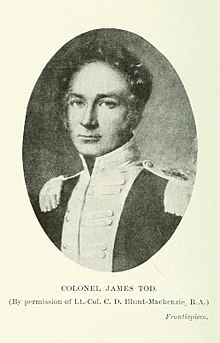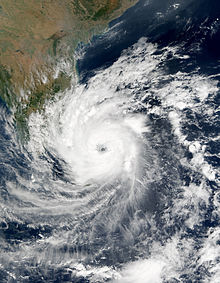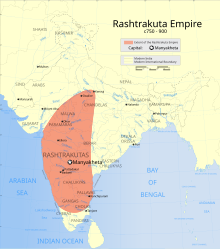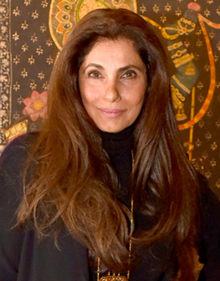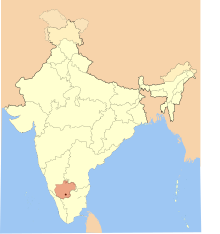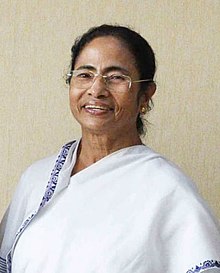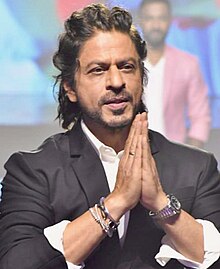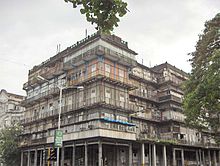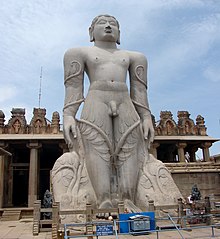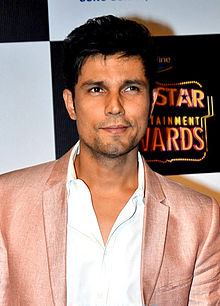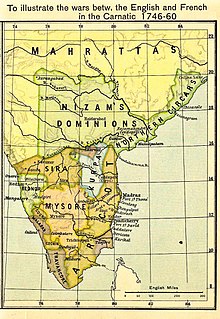Portal:India
Portal maintenance status: (June 2018)
|
Introduction

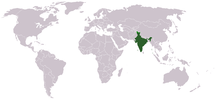
India, officially the Republic of India, is a country in South Asia. It is the seventh-largest country in the world by area and the most populous country. Bounded by the Indian Ocean on the south, the Arabian Sea on the southwest, and the Bay of Bengal on the southeast, it shares land borders with Pakistan to the west; China, Nepal, and Bhutan to the north; and Bangladesh and Myanmar to the east. In the Indian Ocean, India is in the vicinity of Sri Lanka and the Maldives; its Andaman and Nicobar Islands share a maritime border with Thailand, Myanmar, and Indonesia. (Full article...)
 Featured article – show another
Featured article – show another
-
Image 1The frontispiece of the 1920 edition of Tod's Annals and Antiquities of Rajast'han
Lieutenant-Colonel James Tod (20 March 1782 – 18 November 1835) was an officer of the British East India Company and an Oriental scholar. He combined his official role and his amateur interests to create a series of works about the history and geography of India, and in particular the area then known as Rajputana that corresponds to the present day state of Rajasthan, and which Tod referred to as Rajast'han.
Tod was born in London and educated in Scotland. He joined the East India Company as a military officer and travelled to India in 1799 as a cadet in the Bengal Army. He rose quickly in rank, eventually becoming captain of an escort for an envoy in a Sindian royal court. After the Third Anglo-Maratha War, during which Tod was involved in the intelligence department, he was appointed Political Agent for some areas of Rajputana. His task was to help unify the region under the control of the East India Company. During this period Tod conducted most of the research that he would later publish. Tod was initially successful in his official role, but his methods were questioned by other members of the East India Company. Over time, his work was restricted and his areas of oversight were significantly curtailed. In 1823, owing to declining health and reputation, Tod resigned his post as Political Agent and returned to England. (Full article...) -
Image 2
The 2000 Sri Lanka cyclone (IMD designation: BOB 06 JTWC designation: 04B) was the strongest tropical cyclone to strike Sri Lanka since 1978. The fourth tropical storm and the second severe cyclonic storm of the 2000 North Indian Ocean cyclone season, it developed from an area of disturbed weather on December 25, 2000. It moved westward, and quickly strengthened under favorable conditions to reach top wind speeds of 75 mph (121 km/h). The cyclone hit eastern Sri Lanka at peak strength, then weakened slightly while crossing the island before making landfall over southern India on December 28. The storm degenerated into a remnant low later that day, before merging with another trough on the next day.
The storm was the first cyclone over Sri Lanka with winds of at least hurricane strength since a cyclone of 1978 hit the island in the 1978 season, as well as the first tropical storm to hit the island since 1992. The storm was also the first December tropical cyclone of hurricane intensity in the Bay of Bengal since 1996. It produced heavy rainfall and strong winds, damaging or destroying tens of thousands of houses and leaving up to 500,000 homeless. At least nine people died as a result of the cyclone. (Full article...) -
Image 3Rashtrakuta control around 790 AD, during the Tripartite Struggle
The Rashtrakutas were a royal Indian dynasty ruling large parts of the Indian subcontinent between the 6th and 10th centuries. The earliest known Rashtrakuta inscription is a 7th-century copper plate grant detailing their rule from Manapur, a city in Central or West India. Other ruling Rashtrakuta clans from the same period mentioned in inscriptions were the kings of Achalapur and the rulers of Kannauj. Several controversies exist regarding the origin of these early Rashtrakutas, their native homeland and their language.
The Elichpur clan was a feudatory of the Badami Chalukyas, and during the rule of Dantidurga, it overthrew Chalukya Kirtivarman II and went on to build an empire with the Gulbarga region in modern Karnataka as its base. This clan came to be known as the Rashtrakutas of Manyakheta, rising to power in South India in 753 AD. At the same time the Pala dynasty of Bengal and the Prathihara dynasty of Gurjaratra were gaining force in eastern and northwestern India respectively. An Arabic text, Silsilat al-Tawarikh (851), called the Rashtrakutas one of the four principal empires of the world. (Full article...) -
Image 4
Hrithik Roshan (pronounced [ɾɪt̪ɪk ɾoʃən]; born 10 January 1974) is an Indian actor who works in Hindi cinema. He has portrayed a variety of characters and is known for his dancing skills. One of the highest-paid actors in India, he has won many awards, including six Filmfare Awards, of which four were for Best Actor. Starting from 2012, he has appeared in Forbes India's Celebrity 100 several times based on his income and popularity.
Roshan has frequently collaborated with his father, Rakesh Roshan. He made brief appearances as a child actor in several films in the 1980s and later worked as an assistant director on four of his father's films. His first leading role was in the box-office success Kaho Naa... Pyaar Hai (2000), for which he received several awards. Performances in the 2000 terrorism drama Fiza and the 2001 ensemble family drama Kabhi Khushi Kabhie Gham... consolidated his reputation but were followed by several poorly received films. (Full article...) -
Image 5Andha Naal (pronounced [an̪da naːɭ] transl. That Day) is a 1954 Indian Tamil-language mystery-thriller film, produced by A. V. Meiyappan and directed by S. Balachander. It is the first film noir in Tamil cinema, and the first Tamil film to be made without songs, dance, or stunt sequences. Set in the milieu of World War II, the story is about the killing of a radio engineer Rajan (Sivaji Ganesan). The suspects are Rajan's wife Usha (Pandari Bai), the neighbour Chinnaiya Pillai (P. D. Sambandam), Rajan's brother Pattabi (T. K. Balachandran), Rajan's sister-in-law Hema (Menaka), and Rajan's mistress Ambujam (K. Sooryakala). Each one's account of the incident points to a new suspect.
Balachander watched Akira Kurosawa's Rashomon (1950) at a film festival, was inspired by it and wrote a play in the same narrative style, but the script was rejected by All India Radio; Meiyappan later agreed to produce it as the film that would later be titled Andha Naal under AVM Productions. The screenplay was written by Javar Seetharaman, who also played a prominent role as an investigative officer in the film. The cinematography was handled by S. Maruti Rao, and the background score was composed by AVM's own music troupe, Saraswathy Stores Orchestra. The film was shorter than most contemporaneous Tamil films. It was the only film directed by Balachander for AVM. (Full article...) -
Image 6

Darjeeling (/dɑːrˈdʒiːlɪŋ/, Nepali: [ˈdard͡ziliŋ], Bengali: [ˈdarˌdʒiliŋ]) is a city in the northernmost region of the Indian state of West Bengal. Located in the Eastern Himalayas, it has an average elevation of 2,045 metres (6,709 ft). To the west of Darjeeling lies the easternmost province of Nepal, to the east the Kingdom of Bhutan, to the north the Indian state of Sikkim, and farther north the Tibet Autonomous Region region of China. Bangladesh lies to the south and southeast, and most of the state of West Bengal lies to the south and southwest, connected to the Darjeeling region by a narrow tract. Kangchenjunga, the world's third-highest mountain, rises to the north and is prominently visible on clear days.
In the early 19th century, during East India Company rule in India, Darjeeling was identified as a potential summer retreat for British officials, soldiers and their families. The narrow mountain ridge was leased from the Kingdom of Sikkim, and eventually annexed to British India. Experimentation with growing tea on the slopes below Darjeeling was highly successful. Thousands of labourers were recruited chiefly from Nepal to clear the forests, build European-style cottages and work in the tea plantations. The widespread deforestation displaced the indigenous peoples. Residential schools were established in and around Darjeeling for the education of children of the domiciled British in India. By the late-19th century, a novel narrow-gauge mountain railway, the Darjeeling Himalayan Railway, was bringing summer residents into the town and carrying a freight of tea out for export to the world. After India's independence in 1947, as the British left Darjeeling, its cottages were purchased by wealthy Indians from the plains and its tea plantations by out-of-town Indian business owners and conglomerates. (Full article...) -
Image 7
General Hastings Lionel Ismay, 1st Baron Ismay KG, GCB, CH, DSO, PC, DL ('Pug' Ismay) (21 June 1887 – 17 December 1965) was a British politician, diplomat and general in the British Indian Army who was the first secretary general of NATO. He also was Winston Churchill's chief military assistant during the Second World War.
Ismay was born in Nainital, India, in 1887, and educated in the United Kingdom at Charterhouse School and the Royal Military College, Sandhurst. After Sandhurst, he joined the Indian Army as an officer of the 21st Prince Albert Victor's Own Cavalry. During the First World War, he served with the Camel Corps in British Somaliland, where he joined in the British fight against the "Mad Mullah", Mohammed Abdullah Hassan. In 1925, Ismay became an Assistant Secretary of the Committee of Imperial Defence (CID). After being promoted to the rank of colonel, he served as the military secretary for Lord Willingdon, the Viceroy of India, then returned to the CID as Deputy Secretary in 1936. (Full article...) -
Image 8

The Kingdom of Mysore was a geopolitical realm in southern India founded in around 1399 in the vicinity of the modern-day city of Mysore and prevailed until 1950. The territorial boundaries and the form of government transmuted substantially throughout the kingdom's lifetime. While originally a feudal vassal under the Vijayanagara Empire, it became a princely state in British India from 1799 to 1947, marked in-between by major political changes.
The kingdom, which was founded and ruled for the most part by the Wadiyars, initially served as a feudal vassal under the Vijayanagara Empire. With the gradual decline of the Empire, the 16th-century Timmaraja Wodeyar II declared independence from it. The 17th century saw a steady expansion of its territory and, during the rules of Narasaraja Wodeyar I and Devaraja Wodeyar II, the kingdom annexed large expanses of what is now southern Karnataka and parts of Tamil Nadu, becoming a formidable power in the Deccan. (Full article...) -
Image 9Sir Robert Eric Mortimer Wheeler CH CIE MC TD FRS FBA FSA (10 September 1890 – 22 July 1976) was a British archaeologist and officer in the British Army. Over the course of his career, he served as Director of both the National Museum of Wales and London Museum, Director-General of the Archaeological Survey of India, and the founder and Honorary Director of the Institute of Archaeology in London, in addition to writing twenty-four books on archaeological subjects.
Born in Glasgow to a middle-class family, Wheeler was raised largely in Yorkshire before moving to London in his teenage years. After studying classics at University College London (UCL), he began working professionally in archaeology, specialising in the Romano-British period. During World War I he volunteered for service in the Royal Artillery, being stationed on the Western Front, where he rose to the rank of major and was awarded the Military Cross. Returning to Britain, he obtained his doctorate from UCL before taking on a position at the National Museum of Wales, first as Keeper of Archaeology and then as Director, during which time he oversaw excavation at the Roman forts of Segontium, Y Gaer, and Isca Augusta with the aid of his first wife, Tessa Wheeler. Influenced by the archaeologist Augustus Pitt Rivers, Wheeler argued that excavation and the recording of stratigraphic context required an increasingly scientific and methodical approach, developing the "Wheeler method". In 1926, he was appointed Keeper of the London Museum; there, he oversaw a reorganisation of the collection, successfully lobbied for increased funding, and began lecturing at UCL. (Full article...) -
Image 10
Preity G Zinta (pronounced [ˈpriːt̪i ˈzɪɳʈa]; born 31 January 1975) is an Indian actress and entrepreneur primarily known for her work in Hindi films. After graduating with degrees in English honours and criminal psychology, Zinta made her acting debut in Dil Se.. in 1998, followed by a role in Soldier in the same year. These performances earned her the Filmfare Award for Best Female Debut, and she was later recognised for her role as a teenage single mother in Kya Kehna (2000). She established a career as a leading Hindi film actress of the decade with a variety of character types. Her roles, often deemed culturally defiant, along with her unconventional screen persona won her recognition and several accolades.
Following critically appreciated roles in Chori Chori Chupke Chupke (2001), Dil Chahta Hai (2001), Dil Hai Tumhaara (2002), and Armaan (2003), Zinta received the Filmfare Award for Best Actress for her performance in Kal Ho Naa Ho (2003). She starred in two consecutive annual top-grossing films in India, Koi... Mil Gaya (2003) and Veer-Zaara (2004), and was noted for her portrayal of independent, modern Indian women in Salaam Namaste (2005) and Kabhi Alvida Naa Kehna (2006), top-grossing productions in domestic and overseas markets. For her first international role in the Canadian drama Heaven on Earth (2008) she was awarded the Silver Hugo Award for Best Actress and nominated for the Genie Award for Best Actress. She followed this with a hiatus from acting work for several years, with intermittent appearances such as in her self-produced comeback film, Ishkq in Paris (2013), which failed to leave a mark. (Full article...) -
Image 11Mayabazar (transl. Market of illusions) is a 1957 Indian epic Hindu mythological film directed by K. V. Reddy. It was produced by Nagi Reddi and Chakrapani under their banner, Vijaya Productions. The film was shot simultaneously in Telugu and Tamil, with a few differences in the cast. The story is an adaptation of the folk tale Sasirekha Parinayam, which is based on the characters of the epic Mahabharata. It revolves around the roles of Krishna (N. T. Rama Rao) and Ghatotkacha (S. V. Ranga Rao), as they try to reunite Arjuna's son Abhimanyu (Telugu: Akkineni Nageswara Rao, Tamil: Gemini Ganesan) with his love, Balarama's daughter Sasirekha (Savitri). The Telugu version features Gummadi, Mukkamala, Ramana Reddy, and Relangi in supporting roles, with D. Balasubramaniam, R. Balasubramaniam, V. M. Ezhumalai, and K. A. Thangavelu playing those parts in the Tamil version.
The first mythological film produced by their studio, Mayabazar marked a milestone for Nagi Reddi and Chakrapani. In addition to the technical crew, 400 studio workers – including light men, carpenters, and painters – participated in the development of the film. Director Reddy was meticulous with the pre-production and casting phases, which took nearly a year to complete. Though Rama Rao was initially reluctant to play the lead role, his portrayal of Krishna received acclaim and yielded more offers to reprise the same role in several unrelated films. The soundtrack features twelve songs, with most of the musical score composed by Ghantasala. Telugu lyrics were written by Pingali Nagendrarao and Tamil lyrics were written by Thanjai N. Ramaiah Dass. One of those songs, Lahiri Lahiri, was accompanied by the first illusion of moonlight in Indian cinema, shot by cinematographer Marcus Bartley. (Full article...) -
Image 12
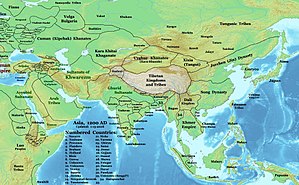
Territory of the Hoysalas and their neighbouring kingdoms in Western India, the Seuna Yadavas and Silharas in c. 1200[image reference needed]
Hoysala literature is the large body of literature in the Kannada and Sanskrit languages produced by the Hoysala Empire (1025–1343) in what is now southern India. The empire was established by Nripa Kama II, came into political prominence during the rule of King Vishnuvardhana (1108–1152), and declined gradually after its defeat by the Khalji dynasty invaders in 1311.
Kannada literature during this period consisted of writings relating to the socio-religious developments of the Jain and Veerashaiva faiths, and to a lesser extent that of the Vaishnava faith. The earliest well-known brahmin writers in Kannada were from the Hoysala court. While most of the courtly textual production was in Kannada, an important corpus of monastic Vaishnava literature relating to Dvaita (dualistic) philosophy was written by the renowned philosopher Madhvacharya in Sanskrit. (Full article...) -
Image 13
Dimple Kapadia (born 8 June 1957) is an Indian actress predominantly appearing in Hindi films. Born and raised in Mumbai by wealthy parents, she aspired to become an actress from a young age and received her first opportunity through her father's efforts to launch her in the film industry. She was discovered at age 14 by the filmmaker Raj Kapoor, who cast her in the title role of his teen romance Bobby (1973), which opened to major commercial success and gained her wide public recognition. Shortly before the film's release in 1973, she married the actor Rajesh Khanna and quit acting. Their daughters, Twinkle and Rinke Khanna, both briefly worked as actresses in their youth. Kapadia returned to films in 1984, two years after her separation from Khanna. Her comeback film Saagar, which was released a year later, revived her career. Both Bobby and Saagar won her Filmfare Awards for Best Actress. Through her work over the next decade, she established herself as one of Hindi cinema's leading actresses.
While her initial roles often relied on her perceived beauty and sex appeal, Kapadia was keen to challenge herself and expand her range. She was among the first actresses who starred in women-centred Hindi action films but found greater favour with critics when she took on more dramatic roles in both mainstream and neorealist parallel cinema. Appearing in films ranging from marital dramas to literary adaptations, she played troubled women sometimes deemed reflective of her personal experience, and received acclaim for her performances in Kaash (1987), Drishti (1990), Lekin... (1991), and Rudaali (1993). For her role as a professional mourner in Rudaali, she won the National Film Award for Best Actress and a Filmfare Critics Award. She also had supporting roles in the crime dramas Prahaar (1991), Angaar (1992), Gardish (1993) and Krantiveer (1994), the latter securing her another Filmfare Award. (Full article...) -
Image 14
The Indian roller (Coracias benghalensis) is a bird of the family Coraciidae. It is 30–34 cm (12–13 in) long with a wingspan of 65–74 cm (26–29 in) and weighs 166–176 g (5.9–6.2 oz). The face and throat are pinkish, the head and back are brown, with blue on the rump and contrasting light and dark blue on the wings and tail. The bright blue markings on the wing are prominent in flight. The sexes are similar in appearance. Two subspecies are recognised.
The Indian roller occurs widely from West Asia to the Indian subcontinent. Often found perched on roadside trees and wires, it is common in open grassland and scrub forest habitats, and has adapted well to human-modified landscapes. It mainly feeds on insects, especially beetles. The species is best known for the aerobatic displays of males during the breeding season. Adult males and females form pair bonds and raise the young together. The female lays 3–5 eggs in a cavity or crevice, which is lined with a thin mat of straw or feathers. The roller is the state bird of three Indian states. It is listed as a species of least concern on the IUCN Red List. (Full article...) -
Image 15
Vidya Balan (pronounced [ʋɪd̪ːja baːlən]; born 1 January 1979) is an Indian actress. Known for pioneering a change in the portrayal of women in Hindi cinema with her roles in female-led films, she is the recipient of several awards, including a National Film Award and seven Filmfare Awards. She was awarded the Padma Shri by the Government of India in 2014.
Vidya aspired to a career in film from a young age and had her first acting role in the 1995 sitcom Hum Paanch. While pursuing a master's degree in sociology from the University of Mumbai, she made several unsuccessful attempts to start a career in film, and featured in television commercials and music videos. She made her film debut by starring in the Bengali film Bhalo Theko (2003) and received praise for her first Hindi film, the drama Parineeta (2005). This was followed by commercial successes in Lage Raho Munna Bhai (2006) and Bhool Bhulaiyaa (2007), but her subsequent roles failed to propel her career forward. (Full article...) -
Image 16
Western Ganga was an important ruling dynasty of ancient Karnataka in India which lasted from about 350 to 999 CE. They are known as "Western Gangas" to distinguish them from the Eastern Gangas who in later centuries ruled over Kalinga (modern Odisha and Northern Andhra Pradesh). The general belief is that the Western Gangas began their rule during a time when multiple native clans asserted their freedom due to the weakening of the Pallava empire in South India, a geo-political event sometimes attributed to the southern conquests of Samudra Gupta. The Western Ganga sovereignty lasted from about 350 to 550 CE, initially ruling from Kolar and later, moving their capital to Talakadu on the banks of the Kaveri River in modern Mysore district.
After the rise of the imperial Chalukyas of Badami, the Gangas accepted Chalukya overlordship and fought for the cause of their overlords against the Pallavas of Kanchi. The Chalukyas were replaced by the Rashtrakutas of Manyakheta in 753 CE as the dominant power in the Deccan. After a century of struggle for autonomy, the Western Gangas finally accepted Rashtrakuta overlordship and successfully fought alongside them against their foes, the Chola Dynasty of Tanjavur. In the late 10th century, north of Tungabhadra river, the Rashtrakutas were replaced by the emerging Western Chalukya Empire and the Chola Dynasty saw renewed power south of the Kaveri river. The defeat of the Western Gangas by Cholas around 1000 resulted in the end of the Ganga influence over the region. (Full article...) -
Image 17

Virupaksha temple at Hampi, the sacred centre at Vijayanagara, the royal capital
Vijayanagara literature in Kannada is the body of literature composed in the Kannada language of South India during the ascendancy of the Vijayanagara Empire which lasted from the 14th through the 16th century. The Vijayanagara empire was established in 1336 by Harihara I and his brother Bukka Raya I. Although it lasted until 1664, its power declined after a major military defeat by the Shahi Sultanates in the battle of Talikota in 1565. The empire is named after its capital city Vijayanagara, whose ruins surround modern Hampi, now a World Heritage Site in Karnataka.
Kannada literature during this period consisted of writings relating to the socio-religious developments of the Veerashaiva and Vaishnava faiths, and to a lesser extent to that of Jainism. Writing on secular topics was popular throughout this period. Authorship of these writings was not limited to poets and scholars alone. Significant literary contributions were made by members of the royal family, their ministers, army commanders of rank, nobility and the various subordinate rulers. In addition, a vast body of devotional folk literature was written by musical bards, mystics and saint-poets, influencing society in the empire. Writers of this period popularised use of the native metres: shatpadi (six-line verse), sangatya (compositions meant to be sung to the accompaniment of a musical instrument), and tripadi (three-line verse). (Full article...) -
Image 18
Kalki Koechlin (/ˈkʌlki kɛˈklæ̃/ ⓘ; born 10 January 1984) is a French actress and writer who works in Hindi films. Known for her unconventional body of work, she is the recipient of several accolades including a National Film Award, a Filmfare Award, and two Screen Awards. Although a French citizen, she has been raised and lived most of her life in India.
Born in Pondicherry, India, Koechlin was drawn to theatre from a young age. She studied drama at Goldsmiths, University of London, and worked simultaneously with a local theatre company. After returning to India, she made her Hindi film debut as Chanda in the black comedy-drama Dev.D (2009), winning the Filmfare Award for Best Supporting Actress for her performance. Subsequently, she starred in two of the highest-grossing Hindi films of their respective release years, the romantic comedy-dramas Zindagi Na Milegi Dobara (2011) and Yeh Jawaani Hai Deewani (2013), both of which garnered her nominations for the Filmfare Award for Best Supporting Actress. Koechlin expanded her career into screenwriting with the crime thriller That Girl in Yellow Boots (2011), in which she also played the lead role. (Full article...) -
Image 19Mughal-e-Azam (transl. The Great Mughal) is a 1960 Indian epic historical drama film produced and directed by K. Asif. Starring Prithviraj Kapoor, Dilip Kumar, Madhubala, and Durga Khote, it follows the love affair between Mughal Prince Salim (who went on to become Emperor Jahangir) and Anarkali, a court dancer. Salim's father, Emperor Akbar, disapproves of the relationship, which leads to a war between father and son.
The development of Mughal-e-Azam began in 1944, when Asif read a 1922 play called Anarkali, by the playwright Imtiaz Ali Taj, which is set in the reign of Emperor Akbar (1556–1605). Production was plagued by delays and financial uncertainty. Before its principal photography began in the early 1950s, the project had lost a financier and undergone a complete change of cast. Mughal-e-Azam cost more to produce than any previous Indian motion picture; the budget for a single song sequence exceeded that typical for an entire film of the period. The soundtrack, inspired by Indian classical and folk music, comprises 12 songs voiced by playback singer Lata Mangeshkar along with Mohammed Rafi, Shamshad Begum, and classical singer Bade Ghulam Ali Khan, and is often cited among the finest in the history of Hindi cinema. (Full article...) -
Image 20
Sonam Kapoor Ahuja (pronounced [soːnəm kəˈpuːr]; born 9 June 1985) is an Indian actress who works in Hindi films. She has received several awards, including a National Film Award and a Filmfare Award. One of the highest-paid Hindi film actresses in the 2010s, Kapoor appeared in Forbes India's Celebrity 100 list from 2012 to 2016.
Kapoor, the daughter of actor Anil Kapoor, began her career as an assistant director on filmmaker Sanjay Leela Bhansali's 2005 film Black. She made her acting debut in Bhansali's romantic drama Saawariya (2007), a box office flop, and had her first commercial success with the romantic comedy I Hate Luv Storys (2010). This was followed by a series of commercial failures and repetitive roles, which garnered her negative reviews. The 2013 box office hit Raanjhanaa marked a turning point in Kapoor's career, garnering her praise and Best Actress nominations at several award ceremonies. (Full article...) -
Image 21

Tripura (/ˈtrɪpʊrə, -ərə/) is a state in northeastern India. The third-smallest state in the country, it covers 10,491 km2 (4,051 sq mi); and the seventh-least populous state with a population of 3.67 million. It is bordered by Assam and Mizoram to the east and by Bangladesh to the north, south and west. Tripura is divided into 8 districts and 23 sub-divisions, where Agartala is the capital and the largest city in the state. Tripura has 19 different tribal communities with a majority Bengali population. Bengali, English and Kokborok are the state's official languages.
The area of modern Tripura — ruled for several centuries by the Manikya Dynasty — was part of the Tripuri Kingdom (also known as Hill Tippera). It became a princely state under the British Raj during its tenure, and acceded to independent India in 1947. It merged with India in 1949 and was designated as a 'Part C State' (union territory). It became a full-fledged state of India in 1972. (Full article...) -
Image 22Kal Ho Naa Ho (transl. Tomorrow may never come, pronounced [kəl ɦoː naː ɦoː]), also abbreviated as KHNH, is a 2003 Indian Hindi-language romantic comedy drama film directed by Nikhil Advani in his directorial debut with a story written by Karan Johar with dialogue by Niranjan Iyengar, and produced by Yash Johar. The film stars Jaya Bachchan, Shah Rukh Khan, Saif Ali Khan, and Preity Zinta, with Sushma Seth, Reema Lagoo, Lillete Dubey, and Delnaaz Irani in supporting roles. In the film, Naina Catherine Kapur (Zinta) and Aman Mathur (Shah Rukh Khan) fall in love, but a secret prevents him from reciprocating his feelings and results in a plan to set Naina up with her best friend, Rohit Patel (Saif Ali Khan).
Collaborating with Johar, Shankar–Ehsaan–Loy composed the soundtrack and score. Anil Mehta, Manish Malhotra, and Sharmishta Roy were the cinematographer, costume designer and art director, respectively. Principal photography took place in Toronto, New York City, and Mumbai from January to October 2003. The soundtrack was released on 27 September 2003 to positive reviews; the title song, "It's The Time To Disco", "Kuch To Hua Hai", and "Pretty Woman" were particularly well-received. (Full article...) -
Image 23Nanakramguda skyline
Hyderabad (/ˈhaɪdərəbæd/ HY-dər-ə-bad; ISO: Haidarābād, Telugu: [ˈɦaɪ̯daɾaːbaːd] ⓘ, Urdu: [ˈɦɛːdəɾaːbaːd]) is the capital and largest city of the Indian state of Telangana. It occupies 650 km2 (250 sq mi) on the Deccan Plateau along the banks of the Musi River, in the northern part of Southern India. With an average altitude of 542 m (1,778 ft), much of Hyderabad is situated on hilly terrain around artificial lakes, including the Hussain Sagar lake, predating the city's founding, in the north of the city centre. According to the 2011 census of India, Hyderabad is the fourth-most populous city in India with a population of 6.9 million residents within the city limits, and has a population of 9.7 million residents in the metropolitan region, making it the sixth-most populous metropolitan area in India. With an output of US$ 95 billion, Hyderabad has the sixth-largest urban economy in India.
The Qutb Shahi dynasty's Muhammad Quli Qutb Shah established Hyderabad in 1591 to extend the capital beyond the fortified Golconda. In 1687, the city was annexed by the Mughals. In 1724, Asaf Jah I, the Mughal viceroy, declared his sovereignty and founded the Asaf Jahi dynasty, also known as the Nizams. Hyderabad served as the imperial capital of the Asaf Jahis from 1769 to 1948. As the capital of the princely state of Hyderabad, the city housed the British Residency and cantonment until Indian independence in 1947. Hyderabad was annexed by the Indian Union in 1948 and continued as a capital of Hyderabad State from 1948 to 1956. After the introduction of the States Reorganisation Act of 1956, Hyderabad was made the capital of the newly formed Andhra Pradesh. In 2014, Andhra Pradesh was split to form the state of Telangana, and Hyderabad became the joint capital of the two states with a transitional arrangement scheduled to end in 2024. Since 1956, the city has housed the Rashtrapati Nilayam, the winter office of the president of India. (Full article...) -
Image 24Keechaka Vadham (transl. The Extermination of Keechaka) is an Indian silent film produced, directed, filmed and edited by R. Nataraja Mudaliar. The first film to have been made in South India, it was shot in five weeks at Nataraja Mudaliar's production house, India Film Company. As the members of the cast were Tamils, Keechaka Vadham is considered to be the first Tamil film. No print of it is known to have survived, making it a lost film.
The screenplay, written by C. Rangavadivelu, is based on an episode from the Virata Parva segment of the Hindu epic Mahabharata, focusing on Keechaka's attempts to woo Draupadi. The film stars Raju Mudaliar and Jeevarathnam as the central characters. (Full article...) -
Image 25
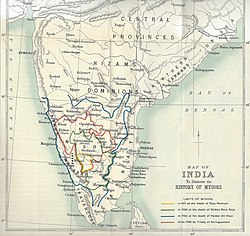
Map 1: Mysore and Coorg in a map of peninsular India showing shifting boundaries
The political history of the region on the Deccan Plateau in west-central peninsular India (Map 1) that was later divided into Mysore state and Coorg province saw many changes after the fall of the Hindu Vijayanagara Empire in 1565. The rise of Sultan Haidar Ali in 1761 introduced a new period.
At the height of the Vijayanagara Empire, the Mysore and Coorg region was ruled by diverse chieftains, or rajas ("little kings"). Each raja had the right to govern a small region, but also an obligation to supply soldiers and annual tribute for the empire's needs. After the empire's fall and the subsequent eastward move of the diminished ruling family, many chieftains tried to loosen their imperial bonds and expand their realms. Sensing opportunity amidst the new uncertainty, various powers from the north invaded the region. Among these were the Sultanate of Bijapur to the northwest, the Sultanate of Golconda to the northeast, the newly-formed Maratha empire farther northwest, and the major contemporary empire of India, the Mughal, which bounded all on the north. For much of the 17th century the tussles between the little kings and the big powers, and amongst the little kings, culminated in shifting sovereignties, loyalties, and borders. By the turn of the 18th century, the political landscape had become better defined: the northwestern hills were being ruled by the Nayaka rulers of Ikkeri, the southwestern—in the Western Ghats—by the Rajas of Coorg, the southern plains by the Wodeyar rulers of Mysore, all of which were Hindu dynasties; and the eastern and northeastern regions by the Muslim Nawabs of Arcot and Sira. Of these, Ikkeri and Coorg were independent, Mysore, although much-expanded, was formally a Mughal dependency, and Arcot and Sira, Mughal subahs (or provinces). (Full article...)
Selected pictures
-
Image 1Photo: Muhammad Mahdi KarimThe glass house at Lal Bagh, a botanical garden in Bangalore, India. The garden was commissioned by the ruler of Mysore, Hyder Ali in 1760, and completed during the reign of his son Tipu Sultan. The glass house was modeled on London's Crystal Palace and constructed at the end of the 19th century.
-
Image 2Photograph: Augustus BinuOdissi is an ancient classical dance that originated in the Hindu temples of Odisha, India. Historically, it has been performed predominantly by women, and expressed religious stories and spiritual ideas, particularly of Vaishnavism (Vishnu as Jagannath), but also of other traditions such as those related to Hindu gods Shiva and Surya, as well as Hindu goddesses (Shaktism). Modern Odissi productions by Indian artists have presented a diverse range of experimental ideas, culture fusion, themes and plays.
Odissi is learnt and performed as a composite of a basic dance motif called the Bhangas (symmetric body bends, stance). It involves the lower, mid, and upper body as three sources of perfecting expression and audience engagement with geometric symmetry and rhythmic musical resonance. -
Image 3Photograph credit: Jeevan JoseLeptosia nina, known as the psyche, is a species of butterfly in the family Pieridae (the sulphurs, yellows and whites), found in the Indian subcontinent, southeastern Asia, and Australia. It has a small wingspan of 2.5 to 5 cm (1 to 2 in). The upper side of the otherwise white forewing has a large, somewhat pear-shaped, black spot; this spot is also present on the underside which is scattered with greenish dots and speckles, sometimes arranged in bands. This L. nina butterfly was photographed in Kerala, India.
-
Image 4Photo credit: Luc ViatourA fire breather in the "Jaipur Maharaja Brass Band" of India. Fire breathing, which is said to have originated in India, is the act of creating a large flame by spraying, with one's mouth, a flammable liquid upon an open flame. A number of legendary creatures are said to possess innate capabilities for fire breathing, most notably dragons.
-
Image 5Photograph: Muhammad Mahdi KarimA panoramic view of Bangalore from Corporation Circle, with UB City to the left and Richmond area to the right. Kanteerava Indoor Stadium is in the foreground. The third largest city in India, the city is known as the Silicon Valley of India for its numerous IT exports.
-
Image 6Photograph: Muhammad Mahdi KarimThe Chota Imambara in Lucknow, Uttar Pradesh, India, is a mausoleum constructed by and for Muhammad Ali Shah, the third Nawab of Awadh, beginning in 1838.
-
Image 7Photograph: Augustus BinuChandiroor Divakaran (b. 1946) is a Malayalam–language poet and folk song writer from Kerala, India. He has published numerous collections of poetry since his debut collection, Radha, in 1965.
-
Image 8Photo: K Hari KrishnanUnripe drupes of black pepper (Piper nigrum) at Trivandrum, Kerala, India. The drupes are cooked briefly in hot water. The heat ruptures cell walls in the pepper, speeding the work of browning enzymes during drying. The drupes are dried for several days, during which the pepper around the seed shrinks and darkens into a thin, wrinkled black layer. Once dried, the spice is called black peppercorn.
-
Image 9Papilio demoleus matingPhotograph: JkadavoorA mating pair of Papilio demoleus, a common and widespread Swallowtail butterfly, photographed at Kadavoor, Kerala, India. After successful mating the female goes from plant to plant, laying a single egg at a time on top of a leaf, and flies off as soon as the egg is laid.
-
Image 10Photograph credit: Charles J. SharpThe southern plains gray langur (Semnopithecus dussumieri) is a species of Old World monkey native to the Indian subcontinent. It is about 62 cm (24 in) tall and lives in groups in various forest habitats, feeding mainly on leaves, fruit and flowers in the canopy, supplementing these with insects, gum, grasses, herbs and roots. The monkeys are considered sacred in India, and some are used by Hindu priests for religious purposes. They have adapted to living in close proximity to humans in urban settings; they are often fed by humans and accept cakes, millet, and other foods. The species is protected by law in India, but some are still persecuted for damaging crops, hunted for food and captured for pets.
This photograph of a female southern plains gray langur was taken in Kanha Tiger Reserve, in the Indian state of Madhya Pradesh. The park was created on 1 June 1955 and was designated a tiger reserve in 1973. -
Image 11Photograph: JJ HarrisonThe Siberian rubythroat (Luscinia calliope) is a small passerine bird generally considered to be an Old World flycatcher of the family Muscicapidae. This migratory insectivorous species breeds in mixed coniferous forest with undergrowth in Siberia, where it nests near the ground. It winters in Thailand, India and Indonesia. It is an extremely rare vagrant to Western Europe and the Aleutian Islands.
-
Image 12Bangalore Town Hall is a neoclassical municipal building in Bangalore, India. It is sometimes known, after a former president of Bangalore, as the Sir K. P. Puttanna Chetty Town Hall. Built by Mirza Ismail in 1935, it underwent renovations in 1990 at a cost of ₹6.5 million (US$371,400 at the time).
-
Image 13Image credit: Vaikunda RajaThe Lotus-Namam is the symbol of Ayyavazhi, a Dharmic belief system that originated in South India in the 19th century. The lotus represents the 1,008-petalled Sahasrara and the flame-shaped white Namam represents the Aanma Jyothi or ātman, sometimes translated as 'soul' or 'self'. The number of practitioners is estimated to be between 700,000 and 8,000,000, although the exact number is unknown, since Ayyavazhis are reported as Hindus during censuses.
-
Image 14Photo: JoydeepCatopsilia pyranthe is a medium sized butterfly of the family Pieridae. It is found in South Asia, Southeast Asia and parts of Australia. This male was photographed in West Bengal, India.
-
Image 15Photograph credit: Charles James SharpDanaus genutia, the common tiger or striped tiger, is a species of brush-footed butterfly found in Sri Lanka, India, Myanmar, south-eastern Asia and Australia. It prefers areas of moderate to heavy rainfall, and typical habitats include scrubby jungle, deciduous forests and fallow land near habitations. The insect sequesters toxins from plants, and advertises its unpalatability by having prominent markings and striking colour patterns. This adult male common tiger, of the subspecies D. g. genutia, was photographed in Kerala, India.
 Featured list – show another
Featured list – show another
-
Image 1
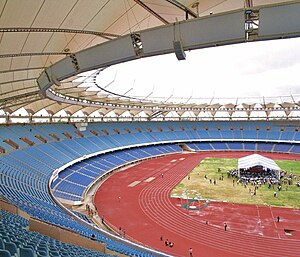
Jawaharlal Nehru Stadium as it appeared in July 2010, was the main venue for the 1982 Asiad.
The 1982 Asian Games (also known as the IX Asiad)[a] was a multi-sport event held in Delhi, India, from 12 November to 4 December 1982. A total of 3,411 athletes from 33 National Olympic Committees (NOCs) participated in these games, competing in 147 events in 21 sports and 22 disciplines. The number of participating countries was the greatest in Asian Games history. Sport events of handball, equestrian, rowing and golf were included for the first time; while fencing and bowling were excluded. This medal table ranks the participating NOCs by the number of gold medals won by their athletes.
Athletes from 23 participating NOCs won at least one medal; athletes from 16 of these NOCs secured at least one gold. Athletes from China won 61 gold medals, the most of any nation at these Asiad, and led the gold-medal count for the first time in their Asiad history. Japan had won the greatest number of medals in previous editions of the Games. China first competed at the Asian Games in 1974, in Tehran, where it finished third. Athletes from both China and Japan won the most total medals with 153. China has secured the top medal spot in every Asiad since 1982. South Korea finished third in total medals. North Korea finished fifth in total medals, and fourth in the gold-medal count. Host nation India finished the games with 57 medals overall (13 gold, 19 silver and 25 bronze, its best performance since 1951), in fifth spot in terms of total gold medals. (Full article...) -
Image 2Prithviraj Sukumaran is the recent winner in 2024
The Kerala State Film Award for Best Actor is an award, begun in 1969, presented annually at the Kerala State Film Awards of India to an actor for best performance in a Malayalam film. Until 1997, the awards were managed directly by the Department of Cultural Affairs of the Government of Kerala. Since 1998, the awards have been constituted by the Kerala State Chalachitra Academy, an autonomous, non-profit institution functioning under the Department of Cultural Affairs. The awardees are decided by a jury constituted every year. They are announced by the Minister for Cultural Affairs and are presented by the Chief Minister.
Throughout the years, accounting for ties and repeat winners, the government has presented 54 Best Actor awards to 35 actors. The recipients receive a figurine, a certificate, and a cash prize of ₹100,000 (US$1,200). Several actors have won the honour for more than one film in a given year. As of 2020, the only actor to have won the prize in consecutive years is Bharat Gopy, in 1982 and 1983. (Full article...) -
Image 3
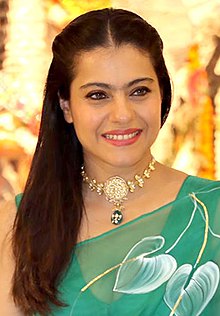
Kajol in 2021
Kajol is an Indian actress who is known for her work in Hindi films and has also acted in 2 Tamil films. She made her screen debut in the 1992 film Bekhudi. She was noted for her performance and went on to sign the 1993 commercially successful thriller Baazigar opposite Shah Rukh Khan. She starred in the 1994 film Udhaar Ki Zindagi, which earned her critical acclaim. This was followed by a role in Yeh Dillagi alongside Akshay Kumar and Saif Ali Khan. Kajol featured in five films in 1995. She appeared briefly in the thriller Karan Arjun, and played Simran, an NRI in Aditya Chopra’s romance Dilwale Dulhania Le Jayenge, both of which ranked among the highest-grossing Bollywood films of the year, and the success of the latter established her career in Bollywood. As of 2021, Dilwale Dulhania Le Jayenge is the longest-running Indian film. Also in 1995, she appeared in the box-office flops Hulchul and Gundaraj. Her only screen appearance of 1996 was in Bambai Ka Babu, a financial failure.
In 1997, Kajol featured in the film Minsara Kanavu, her first Tamil feature. She played an obsessive lover in the mystery film Gupt (1997), and became the first woman to win the Filmfare Award for Best Performance in a Negative Role. Later in 1997, she featured as a poor girl in the romantic film Ishq, a box-office hit. In 1998, she played the leading lady in three romantic comedies, which were among the top-grossing Bollywood productions of the year — Pyaar Kiya To Darna Kya, Pyaar To Hona Hi Tha, and Kuch Kuch Hota Hai. Also in 1998, she played dual roles in the drama Dushman. The following year, she played the secret lover of Ajay Devgn's character in Dil Kya Kare and starred in the commercially successful film Hum Aapke Dil Mein Rehte Hain opposite Anil Kapoor. Following this, she starred in the films Raju Chacha (2000) and Kuch Khatti Kuch Meethi (2001), both of which performed poorly at the box-office. (Full article...) -
Image 4
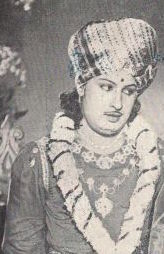
M. G. Ramachandran in Mohini (1948)
M. G. Ramachandran (17 January 1917 – 24 December 1987), popularly known by his initials "MGR", was an Indian actor, film director and film producer who had an extensive career primarily in Tamil language films. After starring in numerous commercially successful films from the 1950s to the early 1970s, he has continued to hold a matinée idol status in Tamil Nadu. Ramachandran made his debut in Ellis R. Dungan's 1936 film Sathi Leelavathi, where he played a police inspector. He followed it with a string of minor appearances and supporting roles in many films, notably Ashok Kumar (1941), where he played the general of emperor Ashoka's army, and as a captain in Dungan's Meera (1945).
Ramachandran's breakthrough came with his first lead role in A. S. A. Sami's swashbuckler film Rajakumari (1947) where he played a villager who marries a princess. Based on the Arabian Nights, Rajakumari was a commercially successful venture. He established himself as an action hero akin to Errol Flynn and Douglas Fairbanks in Tamil cinema with Manthiri Kumari (1950) and Marmayogi (1951). Both films had political undertones which earned Ramachandran a Robin Hood persona of being a champion for the downtrodden. His performance as the caring brother Rajendran who tries to keep his family together in En Thangai (1952) earned him critical acclaim. In 1953, he made his debut in Malayalam films opposite B. S. Saroja in Genova. Ramachandran continued to play roles which enabled him to adopt his ideas of fighting injustice meted out to the poor such as an outlaw in Malaikkallan (1954), and Nadodi Mannan (1958). In the latter, he featured in dual roles, as a king and a commoner, for the first time in his career. Both Malaikkallan and Nadodi Mannan were commercially successful, becoming the highest-grossing films of their respective release years. In addition to social dramas, Ramachandran received positive feedback and commercial success for swashbuckler films such as Alibabavum 40 Thirudargalum (1956), the first South Indian full-length colour film, Madurai Veeran (1956), Chakravarthi Thirumagal and Mahadevi (both released in 1957). (Full article...) -
Image 5
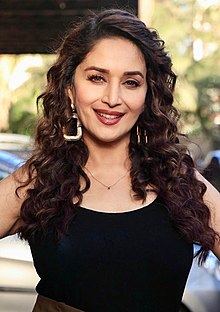
Dixit in 2019
Indian actress Madhuri Dixit made her acting debut in 1984 with Abodh where she portrayed a young bride. Dixit went on to appear in several films over the next three years, including the dramas Awara Baap (1985) and Swati (1986), though none of them garnered her much recognition. The role of Mohini in N. Chandra's action romance drama Tezaab (1988) proved to be a breakthrough for Dixit. The film went on to become the highest-grossing film of that year. For her performance, Dixit received a Best Actress nomination at Filmfare. She achieved further success by featuring as the female lead in several top-grossing action-dramas, including Ram Lakhan (1989), Tridev (1989), and Kishen Kanhaiya (1990). The role of a wealthy brat in the 1990 romantic drama Dil earned Dixit her first Filmfare Award for Best Actress. The following year, she starred in another box-office hit Saajan, and won a second Best Actress award at Filmfare for portraying the role of a strong woman who rebels against her manipulative mother-in-law in the 1992 drama Beta.
She featured alongside Jackie Shroff and Sanjay Dutt in the action thriller Khalnayak (1993), one of the highest-grossing films of that year. Subsequently, she played an avenger in the drama Anjaam (1994) to positive reviews. Dixit's subsequent release was Sooraj Barjatya's Hum Aapke Hain Koun..! (1994), a family drama which emerged as the highest-grossing Bollywood film to that point. The following year, she featured in Raja (1995) which was a blockbuster film of that year and Yaraana in which she played a woman who attempts an escape from her abusive husband. Both of her releases in 1996—Rajkumar and Prem Granth—were financial failures. Dixit's portrayal of a headstrong dancer in Yash Chopra's 1997 romance Dil To Pagal Hai was a major success, earning her a fourth Filmfare Award for Best Actress. She garnered critical acclaim for her work in the dramas Mrityudand (1997), Wajood (1998) and Pukar (2000). She portrayed five roles in the experimental film Gaja Gamini (2000). (Full article...) -
Image 6
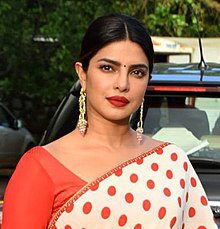
Chopra Jonas in 2019
Priyanka Chopra is an Indian actress, known for her roles in Hindi and English films. Chopra made her acting debut with the 2002 Tamil film Thamizhan. She made her Bollywood debut the following year with the spy thriller The Hero: Love Story of a Spy. The same year, Chopra's role in the box-office hit romance Andaaz won her the Filmfare Award for Best Female Debut and her first Filmfare Award for Best Supporting Actress nomination. In 2004, she starred in the commercially successful romantic comedy Mujhse Shaadi Karogi and garnered high critical acclaim for her breakthrough role in the romantic thriller Aitraaz which earned her the Filmfare Award for Best Performance in a Negative Role and a second Best Supporting Actress nomination. Chopra starred in six films in 2005, including Waqt and Bluffmaster!. In 2006, she starred in two of the highest-grossing films of the year—the superhero film Krrish and the action thriller Don.
In 2007 and 2008, Chopra starred in several critical and commercial failures, but in late 2008, her role in the acclaimed drama Fashion proved to be a turning point in her career. Her portrayal of a troubled model won her the National Film Award for Best Actress and the Filmfare Award for Best Actress. In 2009, Chopra starred in Vishal Bhardwaj's acclaimed caper thriller Kaminey, and played twelve distinct characters in the romantic comedy What's Your Raashee?. She won the Filmfare Award for Best Actress (Critics) for her portrayal of a serial killer in Bhardwaj's 2011 black comedy 7 Khoon Maaf. (Full article...) -
Image 7
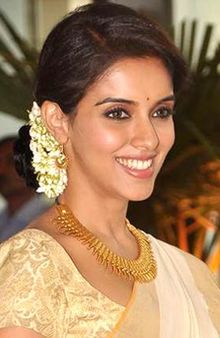
Asin in 2012
Asin is a former Indian actress who is known for her work in Tamil, Telugu and Hindi language films. She made her acting debut at the age of 15 in the Malayalam-language satirical comedy-drama Narendran Makan Jayakanthan Vaka in 2001. Asin had her first commercial success with the Telugu film Amma Nanna O Tamila Ammayi (2003). For her performance as a Tamil girl in the film, she received the Filmfare Best Telugu Actress Award. In the same year she won the Santosham Best Actress Award for her role in Telugu film Sivamani. In her next two Telugu releases: Lakshmi Narasimha (2004) and Gharshana (2004), Asin played the love interest of a police officer. Lakshmi Narasimha was a commercial success, while Gharshana received mixed reviews from critics but later gained a cult following.
She made her debut in Tamil cinema in the 2004 sports drama M. Kumaran Son of Mahalakshmi, a commercial success. The 2005 action thriller Ghajini marked a turning point in her career. Her role as a vivacious young model named Kalpana won her the Filmfare Best Tamil Actress Award. This led to a series of lead roles in commercially successful films, including the action film Sivakasi (2005), the thriller Varalaru (2006), the action thriller Pokkiri (2007), the action drama Vel (2008) and the science fiction film Dasavathaaram (2008), which established her as a leading actress of Tamil cinema. (Full article...) -
Image 8

Mukerji in 2021
Hindi film actress Rani Mukerji made her screen debut in Biyer Phool (1996), a Bengali film directed by her father Ram Mukherjee. Her first leading role was that of a rape victim in the 1996 social drama Raja Ki Aayegi Baaraat. In 1998 she received wider recognition for her role alongside Aamir Khan in the action film Ghulam, and had her breakthrough as the romantic interest of Shah Rukh Khan's character in the romantic drama Kuch Kuch Hota Hai. The latter earned Mukerji her first Filmfare Award in the Best Supporting Actress category. She followed this by playing the leading lady in several films, including Hello Brother (1999) and Nayak: The Real Hero (2001), none of which helped propel her career forward.
Mukerji's career prospects improved in 2002 when she starred in Yash Raj Films' Saathiya, a romantic drama that gained her a Filmfare Critics Award for Best Actress. For her roles in the 2004 romantic comedy Hum Tum and the composite drama Yuva, Mukerji became the only actress to win both the Filmfare Award for Best Actress and Best Supporting Actress, respectively, in the same year. Also that year, she starred in Veer-Zaara—the highest-grossing Bollywood film of the year. In 2005, she received praise for portraying a blind, deaf and mute woman in the drama Black, and played a con woman in the crime comedy film Bunty Aur Babli. For her performance in Black, she was awarded the Best Actress and Best Actress (Critics) trophies at Filmfare. The following year, she played an unhappily married woman in the drama Kabhi Alvida Naa Kehna — the top-grossing Bollywood film in overseas at that point. (Full article...) -
Image 9
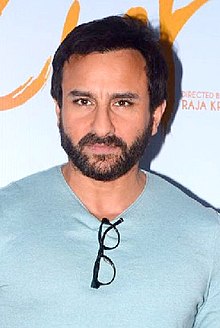
Khan in 2017
Saif Ali Khan is an Indian actor who works in Hindi films. He made his debut with a leading role in the drama Parampara (1993) and then starred in Aashik Awara (1993). Yeh Dillagi (1994). Main Khiladi Tu Anari (1994). Tu Chor Main Sipahi (1996). Keemat: They Are Back (1998). Aarzoo (1999). Tashan (2008). Sanam Teri Kasam (2009) The latter earned him the Filmfare Award for Best Male Debut, but failed to do well commercially, as did his next three releases–Parampara (1993), Pehchaan (1993), and Imtihaan (1994). Later in 1994, Khan played supporting roles alongside Akshay Kumar in two of the highest-grossing films of the year–the romance Yeh Dillagi and the action drama Main Khiladi Tu Anari. For his performance in the latter, he was nominated for the Filmfare Award for Best Supporting Actor. This success was followed by a series of commercial failures, leading to a setback in Khan's career.
Khan played the second lead in Milan Luthria's action thriller Kachche Dhaage (1999) and Aarzoo (1999)?which was his first commercial success since Main Khiladi Tu Anari; it also earned him another nomination for Best Supporting Actor at Filmfare. Also that year, he starred in the ensemble drama Hum Saath-Saath Hain–the highest-grossing film of the year. In 2000, Khan starred in the drama Kya Kehna, which marked his first of many collaborations with actress Preity Zinta. In 2001, he played alongside Aamir Khan and Akshaye Khanna in Farhan Akhtar's coming of age drama Dil Chahta Hai, which earned him his first Filmfare Award for Best Comedian. It brought a change in his approach and established him as a serious actor. Khan featured in Nikhil Advani's romantic drama Kal Ho Naa Ho (2003), which became the second highest-grossing film of the year and earned him his second Filmfare Award for Best Supporting Actor. In 2004, he played a manipulative pimp in the thriller Ek Hasina Thi and a cartoonist in the romantic comedy Hum Tum. His performance in the latter earned him the National Film Award for Best Actor and a second Filmfare Award for Best Comedian. The following year, Khan reunited with Zinta in the romantic comedy Salaam Namaste (2005) and received his first Best Actor nomination at Filmfare for portraying a passionate musician in the musical romance Parineeta (2005). (Full article...) -
Image 10
The Chief Minister of West Bengal (IAST: Paścim Baṅgēr Mukhya Mantrī) is the de facto head of the executive branch of the Government of West Bengal, the subnational authority of the Indian state of West Bengal. The chief minister is head of the Council of Ministers and appoints ministers. The chief minister, along with their cabinet, exercises executive authority in the state. The governor appoints the chief minister, whose council of ministers are collectively responsible to the assembly.
On 17 August 1947, the British Indian province of Bengal was partitioned into the Pakistani province of East Bengal and the Indian state of West Bengal. Since then West Bengal has had seven chief ministers, starting with Prafulla Chandra Ghosh of the Indian National Congress (INC) party as the premier (elected to lead the assembly while the chief minister is not appointed). Dr. Bidhan Chandra Roy in 1950 became the first formal Chief Minister of West Bengal after the implementation of the Indian Constitution. A period of political instability followed thereafter—West Bengal witnessed three elections, four coalition governments and three stints of President's rule between 1967 and 1972—before Siddhartha Shankar Ray of the INC served a five-year term. (Full article...) -
Image 11Khan at an event for Jawan in 2023
Shah Rukh Khan is an Indian actor, producer and television personality who works in Hindi films. He began his acting career by playing a soldier in the Doordarshan series Fauji (1988), a role that garnered him recognition and led to starring roles in more television shows. He soon started receiving film offers and had his first release with the romantic drama Deewana (1992), in which he played a supporting part. Khan subsequently played villainous roles in the 1993 thrillers Baazigar and Darr, box office successes that established his career in Bollywood. In 1995, Khan starred opposite Kajol in Aditya Chopra's romance Dilwale Dulhania Le Jayenge, that became the longest running Indian film of all time. He continued to establish a reputation in romantic roles by playing opposite Madhuri Dixit in Dil To Pagal Hai (1997), and Kajol in the Karan Johar-directed Kuch Kuch Hota Hai (1998) and Kabhi Khushi Kabhie Gham... (2001).
In 1999, Khan collaborated with Aziz Mirza and Juhi Chawla to start a production company, Dreamz Unlimited, whose first release was the comedy-drama Phir Bhi Dil Hai Hindustani (2000) starring Khan and Chawla. The film was a commercial failure as was their next production, Aśoka (2001), leading to a setback. His career prospects improved in 2002 when he starred alongside Dixit and Aishwarya Rai in Devdas, a period romance that garnered him critical acclaim. In 2004, he collaborated with his wife Gauri Khan to launch another company, Red Chillies Entertainment, whose first feature was the box office hit Main Hoon Na (2004). Khan's popularity continued to increase in the 2000s as he played the romantic lead opposite younger actresses, most notably Rani Mukerji and Preity Zinta, in several top-grossing productions, including Kal Ho Naa Ho (2003), Veer-Zaara (2004) and Kabhi Alvida Naa Kehna (2006). He also played against type as a NASA scientist in the drama Swades (2004), a hockey coach in the sports film Chak De! India (2007), and an autistic man in the drama My Name Is Khan (2010). (Full article...) -
Image 12
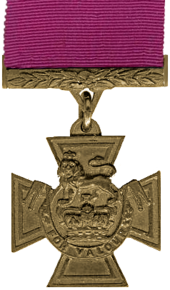
The Victoria Cross
The Victoria Cross (VC) was awarded to 153 members of the British Indian Army and civilians under its command, from 1857 until independence in 1947. The Victoria Cross is a military decoration awarded for valour "in the face of the enemy" to members of armed forces of some Commonwealth countries and previous British Empire territories. It takes precedence over all other Orders, decorations and medals. It may be awarded to a person of any rank in any service and to civilians under military command. The VC is traditionally presented to the recipient by the British monarch during an investiture at Buckingham Palace, though in a large number of cases this was not possible and it was presented in the field by a prominent civil or military official. The VC was introduced in Great Britain on 29 January 1856 by Queen Victoria to reward acts of valour during the Crimean War.
Indian troops were not originally eligible for the VC, because since 1837 they had been eligible for the Indian Order of Merit—the oldest British gallantry award for general issue. When the VC was created, Indian troops were still controlled by the British East India Company, and did not come under Crown control until 1860. European officers and men serving with the East India Company were not eligible for the Indian Order of Merit; the VC was extended to cover them in October 1857. It was only at the end of the 19th century that calls for Indian troops to be awarded the VC intensified. Indian troops became eligible for the award in 1911. The first awards to Indian troops appeared in The London Gazette on 7 December 1914 to Darwan Singh Negi and Khudadad Khan, whose gallantry on 31 October 1914 was nearly a month earlier than Negi's gallantry on 24/25 November. Negi was presented with the VC by King George V two days earlier, on 5 December 1914, during a visit to troops in France. He is one of a small number of soldiers presented with his award before it appeared in the London Gazette. (Full article...) -
Image 13Paradesi (transl. Vagabond) is a 2013 Indian Tamil-language period drama film written, produced and directed by Bala. The film features Atharvaa and Vedhika in the lead roles, with Sai Dhanshika, Uday Karthik, Riythvika and Jerry in supporting roles. The soundtrack and score were composed by G. V. Prakash Kumar. The cinematography was handled by Chezhiyan, while Kishore Te and L. V. K. Das were in charge of the editing. Based on Paul Harris Daniel's 1969 novel Red Tea, the film's story revolves around Raasa (Atharvaa), an unemployed villager who is misled into bonded labour at a tea plantation after being promised generous accommodation and wages by its supervisor (Jerry).
Paradesi was made on a budget of ₹400 million and was released on 15 March 2013 to critical acclaim, but failed at the box office. The film won 37 awards from 59 nominations; its direction, performances of the cast members, music, cinematography, and costumes have received the most attention from award groups. (Full article...) -
Image 14The Pampa Award (or Pampa Prashasti) is a literary award in the Indian state of Karnataka. The award was established in 1987 by the government of Karnataka. It is the highest literary honor conferred by the Department of Kannada and Culture, Government of Karnataka State, and recognises works written in the Kannada language (1 of the 22 official languages of India).
The award is named after the first Kannada poet Adikavi Pampa. The award originally comprised a cash prize of ₹1 lakh (US$1,200), a shawl, a citation and a memento. The cash prize was increased to ₹3 lakh (US$3,600) in 2008. Prior to 1996, the awards were given for a best single work by a Kannada writer. Since then, the award has been given to writers for their lifetime contribution to the Kannada literature. The Pampa Prashasti is presented by the Chief Minister, during the Kadambotsava, a cultural festival held annually in Pampa's hometown of Banavasi in Uttara Kannada district. (Full article...) -
Image 15
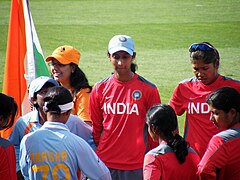
Members of the Indian cricket team before a Women's World Twenty20 game in Sydney, 2009
The India women's national cricket team represents India in international women's cricket. A full member of the International Cricket Council (ICC), the team is governed by the Board of Control for Cricket in India (BCCI). The India women's national cricket team first competed in 1976 when they played the West Indies in a six-match Test series at home. They recorded their first victory in the fourth match held at the Moin-ul-Haq Stadium, Patna; however, a loss in the sixth match led to the series being tied. India secured their first overseas victory in a one-off series against South Africa in 2002. As of October 2022[update], they have played 38 Test matches against five different opponents—Australia, England, South Africa, New Zealand and the West Indies. In terms of victories, they have been most successful against England and South Africa with two wins against each of them.
India played their first Women's One Day International cricket (WODI) match against England in the 1978 World Cup, which they hosted. They finished at the bottom of the table as they lost the remaining two games of the group stage. In the 1982 World Cup, they won their first ever WODI match when they beat the International XI by 79 runs at McLean Park, Napier. India's first overseas WODI series win came at the 1994–95 New Zealand Women's Centenary Tournament. They won the WODI series during their tour 1999 of England. They were the runner-up at the 2005 and the 2017 World Cup tournaments. As of October 2022[update], they have played 301 WODIs against twelve different opponents, and have the fourth highest number of victories (164) for any team in the format; They have recorded 81 wins and have been the fifth most successful team in the T20 format. Since their first Women's Twenty20 International (WT20I) against England in August 2006, India have played 151 matches. They have been most successful against Bangladesh with eleven wins against them. They were among the semi-finalists in the 2009 and 2010 ICC Women's World Twenty20 tournaments. (Full article...) -
Image 16
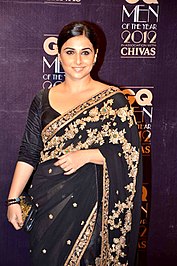
Vidya Balan's performance in Kahaani garnered her several awards and nominations
Kahaani (transl. Story) is a 2012 Indian mystery thriller film directed and co-produced by Sujoy Ghosh. The film stars Vidya Balan as the protagonist, and features Parambrata Chatterjee, Nawazuddin Siddiqui, and Saswata Chatterjee in supporting roles. The film was edited by Namrata Rao, with the cinematography provided by Setu. Set in the city of Kolkata during the festivities of Durga Puja, Kahaani follows the life of a pregnant woman, Vidya Bagchi (Vidya Balan), in search of her husband, a man whose existence is denied by the people she encounters.
Made on a budget of ₹80 million (US$960,000), Kahaani was released on 9 March 2012 and grossed over ₹1.04 billion (US$12 million) worldwide after a 50-day theatrical run. The film garnered awards and nominations in several categories, with particular praise for its direction and the performance of the lead actress. As of 2014, the film has won 28 awards. (Full article...) -
Image 17The Sunrisers Hyderabad (often abbreviated as SRH) are a franchise cricket team based in Hyderabad, Telangana, that compete in the Indian Premier League (IPL). The team is owned by Kalanithi Maran of the Sun TV Network who won the bid for the franchise at ₹850.5 million per year on a five-year deal in 2012 following the termination of the previous Hyderabad-based franchise, Deccan Chargers, from the IPL. Having made its first IPL playoffs appearance in its debut season in 2013, the team has qualified for the playoffs every year since the 2016 season. They have reached the finals twice, most recently during the 2018 season, and won their only title in the 2016 season after defeating the Royal Challengers Bangalore by 8 runs in the Final.
As of June 2022[update], the team was captained by Kane Williamson and coached by Tom Moody with Simon Helmot as assistant coach, Muttiah Muralitharan and Dale Steyn as bowling coaches, Brian Lara as batting coach and Hemang Badani as fielding coach. The team has played its home matches in the 55,000-capacity Rajiv Gandhi International Cricket Stadium in Hyderabad since its inception. The coronavirus pandemic impacted the brand value of the Sunrisers Hyderabad which was estimated to be US$57.4million in 2020 as the overall brand of IPL was decreased to US$4.4billion, according to Brand Finance. (Full article...) -
Image 18
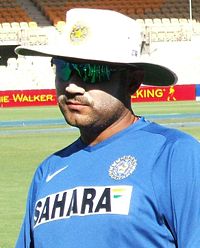
Virender Sehwag scored 23 centuries in Test matches and 15 in One Day Internationals for India.
Virender Sehwag is an Indian cricketer whose aggressive batting has found success at the top of the batting order. He has scored centuries (100 or more runs) on 23 occasions in Test cricket and in 15 One Day International (ODI) matches but has not scored a century in a Twenty20 international.
In Tests, Sehwag has scored centuries against all the Test-cricket playing nations except Bangladesh and Zimbabwe, and is fifth on the list of leading Test century makers for India. In 2001, he became the eleventh Indian player to score a century on Test debut, with 105 runs against South Africa. His centuries have been scored at fourteen cricket grounds, eight of which were outside India. He has made six scores of 200 runs or more, of which a record three have come against Pakistan. One such innings, the 254 in Lahore, had him involved in a 410-run partnership with Rahul Dravid, which came within 3 runs of breaking the record for the highest first-wicket partnership in Tests, set by Pankaj Roy and Vinoo Mankad. The innings took only 247 balls and was the highest score at faster than a run a ball. Sehwag is the first Indian to score a triple century (300 or more runs), and has done so twice—309 against Pakistan in Multan in 2004 and 319 against South Africa in Chennai in 2008. The latter is the fastest triple century in Test cricket, the 300 coming up off just 278 balls, and is also the highest score with a strike rate over 100. It was also rated as one of the top 10 Test innings of all time by the ICC rankings, and received special mention along with his 201* in Galle, in which he carried his bat as he was named the Wisden Leading Cricketer in the World in 2008. He is one of the only four batsmen to score two triple centuries, alongside Sir Donald Bradman, Brian Lara and Chris Gayle. He scored 12 centuries that have been converted to scores of 150 or greater, a record for the most consecutive hundreds of over 150. He has been dismissed five times in the nineties. (Full article...) -
Image 19
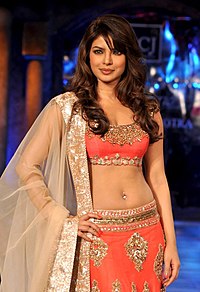
Priyanka Chopra won several awards, including the National and Filmfare awards for Best Actress for her performance in Fashion
Fashion is a 2008 Indian drama film directed by Madhur Bhandarkar and produced by UTV Motion Pictures. The film features Priyanka Chopra in the lead role, with Kangana Ranaut, Mugdha Godse, Arbaaz Khan and Arjan Bajwa in supporting roles as well as several professional fashion models playing themselves. Bhandarkar co-wrote the film with Ajay Monga and Anuraadha Tewari. Deven Murdeshwar edited the film while the cinematography was provided by Mahesh Limaye. Salim–Sulaiman composed the musical score, with lyrics written by Irfan Siddiqui and Sandeep Nath. The film focuses on the transformation of Meghna Mathur, an aspiring fashion model played by Chopra, from a small-town girl to a supermodel in the Indian fashion industry.
Produced on a budget of ₹180 million (US$2.2 million), Fashion was released on 29 October 2008 to critical acclaim and box-office success. It grossed ₹600 million (US$7.2 million) and was noted for being commercially successful despite being a women-centric film with no male lead. Fashion received various awards and nominations, with praise for its direction, the performance of the cast, screenplay, editing, musical score, and costume design. (Full article...) -
Image 20
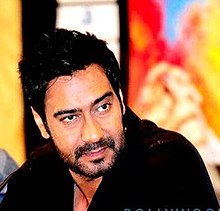
Devgn at an event for his film Drishyam in 2015
Ajay Devgn is an Indian actor, director and producer who works in Hindi films. He debuted as an actor in Phool Aur Kaante (1991), which won him the Filmfare Award for Best Male Debut. Devgn then played a kickboxer in the martial arts film Jigar (1992) and a blind in Vijaypath (1994) and starred in Suhaag (1994), Dilwale (1994), Diljale (1996), Jaan (1996), Ishq (1997), Pyaar To Hona Hi Tha (1998), and Hum Dil De Chuke Sanam (1999). He garnered Filmfare Best Actor nominations for Naajayaz and Hum Dil De Chuke Sanam and also won his first National Film Award for Best Actor for his performance in Zakhm (1998). In 2000, Devgn started Ajay Devgn FFilms, producing and headlining the commercially unsuccessful Raju Chacha. He received a Filmfare Best Supporting Actor nomination for enacting a dacoit in the ensemble film Lajja (2001).
2002 proved to be a banner year for Devgn as he received universal acclaim for his performances in Company, The Legend of Bhagat Singh and Deewangee. He won his second National Award for portraying revolutionary Bhagat Singh in The Legend of Bhagat Singh and the Filmfare Critics Award for Best Actor for it and Company, along with a Filmfare Best Villain Award for Deewangee. In 2003, he acted in the Bhoot, a sleeper hit, and played a police officer in Gangaajal, which earned him another Filmfare Best Actor nomination. He was next featured in Yuva (2004), Kaal (2005), and Omkara (2006). Rohit Shetty's Golmaal series established Devgn in comic roles, producing Golmaal (2006), Golmaal Returns (2008) and Golmaal 3 (2010). However Devgn was highly panned for Aag (2007), based on the 1975 cult classic Sholay. Today, it is considered one of the worst films. In 2008, he made his directorial debut with his own production U Me Aur Hum. 2010 proved to be a milestone year for him as he delivered his first 100 Crore Club film with Golmaal 3 and received positive feedback for the top-grossing films Raajneeti and Once Upon a Time in Mumbaai. The latter fetched him a Filmfare Best Actor nomination, as like his next Singham (2011), the first part of Shetty's Cop Universe, which was later reprised in Singham Returns (2014) and briefly in other standalone films of the universe, culminating in Singham Again (2024). (Full article...) -
Image 21

Sanjay Dutt at Mumbai Airport
Sanjay Dutt is an Indian actor known for his work in Hindi films as well as a few Telugu, Kannada, Tamil, and Punjabi films. He made his acting debut in 1981, opposite Tina Ambani, in his father Sunil Dutt's romantic action film Rocky (1981). Rocky was ranked at tenth highest-grossing Bollywood films of 1981. After appearing in a series of box office flops, he starred in Mahesh Bhatt's crime thriller film Naam (1986). Dutt received critical acclaim for his performance, and it became a turning point in his career.
In 1991, Dutt appeared in Lawrence D'Souza's Indian romantic drama film Saajan (1991), starring alongside Madhuri Dixit and Salman Khan. For his performance, Dutt was nominated for the Filmfare Award for Best Actor. He was nominated again for the same award for his performance in Khalnayak (1993). Dutt won the Filmfare Award for Best Actor—for portraying a young man who later becomes a gangster in Vaastav: The Reality (1999). He also received critical acclaim for his performance. Dutt next appeared in Vidhu Vinod Chopra's crime thriller film Mission Kashmir (2000). For his performance, Dutt was nominated for the Filmfare Award for Best Actor. (Full article...) -
Image 22

Vidya in 2023
Indian actress Vidya Balan made her acting debut in 1995 with the sitcom Hum Paanch, following which she made several unsuccessful attempts at a film career. Vidya then appeared in music videos for Euphoria, Pankaj Udhas, and Shubha Mudgal all directed by Pradeep Sarkar. She had her first film release with a leading role in Goutam Halder's Bengali film Bhalo Theko (2003). In 2005, she starred in Sarkar's Parineeta, an adaptation of Sarat Chandra Chattopadhyay's novel, which won her the Filmfare Award for Best Female Debut. Rajkumar Hirani's Lage Raho Munna Bhai (2006), a successful comedy sequel, saw her play a radio jockey opposite Sanjay Dutt.
Vidya played a variety of roles in 2007, including a woman suffering from multiple sclerosis in Mani Ratnam's drama Guru, a single mother in the comedy Heyy Babyy, and a dissociative identity disorder patient in the thriller Bhool Bhulaiyaa. All three films were commercially successful and established her as a leading lady. This was followed by two commercial failures in 2008. From 2009 to 2012, Vidya starred in five consecutive films that garnered her critical and commercial success. She played the mother of a child afflicted with progeria in Paa (2009), a seductive widow in Ishqiya (2010), and the real-life character of Sabrina Lal in No One Killed Jessica (2011). For portraying the actress Silk in the biopic The Dirty Picture, Vidya won the National Film Award for Best Actress. She next played a pregnant woman seeking revenge in the thriller Kahaani (2012), directed by Sujoy Ghosh. She was awarded the Filmfare Award for Best Actress for her roles in Paa, The Dirty Picture, and Kahaani, and the Filmfare Critics Award for Best Actress for Ishqiya. (Full article...) -
Image 23The prime minister of India is the chief executive of the Government of India and chair of the Union Council of Ministers. Although the president of India is the constitutional, nominal, and ceremonial head of state, in practice and ordinarily, the executive authority is vested in the prime minister and their chosen Council of Ministers. The prime minister is the leader elected by the party with a majority in the lower house of the Indian parliament, the Lok Sabha, which is the main legislative body in the Republic of India. The prime minister and their cabinet are at all times responsible to the Lok Sabha. The prime minister can be a member of the Lok Sabha or of the Rajya Sabha, the upper house of the parliament. The prime minister ranks third in the order of precedence.
The prime minister is appointed by the president of India; however, the prime minister has to enjoy the confidence of the majority of Lok Sabha members, who are directly elected every five years, unless a prime minister resigns. The prime minister is the presiding member of the Council of Ministers of the Union government. The prime minister unilaterally controls the selection and dismissal of members of the council; and allocation of posts to members within the government. This council, which is collectively responsible to the Lok Sabha as per Article 75(3), assists the president regarding the operations under the latter's powers; however, by the virtue of Article 74 of the Constitution, such 'aid and advice' tendered by the council is binding. (Full article...) -
Image 24The 2022 recipient: Pavan Malhotra
The National Film Award for Best Actor in a Supporting Role (known as National Film Award for Best Supporting Actor prior to 69th NFA) is an honour presented annually at India's National Film Awards ceremony by the National Film Development Corporation of India (NFDC), an organisation set up by the Indian Ministry of Information and Broadcasting. A national panel appointed annually by the NFDC selects the actor who has given the best performance in a supporting role within Indian cinema. The award is presented by the President of India at a ceremony held in New Delhi. Since the 70th National Film Awards, the name was changed to "Best Actor in a Supporting Role".
The winner is given a "Rajat Kamal" (Silver Lotus) certificate and a cash prize of ₹2 lakh (US$2,400). Including ties and repeat winners, the government of India has presented a total of 32 Best Supporting Actor awards to 29 different actors. Although Indian cinema produces films in more than 20 languages, the actors whose performances have won awards have worked in one or more of seven major languages: Hindi (18 awards), Tamil (9 awards), Bengali (3 awards), Malayalam (4 awards), Marathi (3 awards), Telugu (1 award), Kannada (1 award). (Full article...) -
Image 25

The Padma Bhushan is the third-highest civilian award of the Republic of India. Instituted on 2 January 1954, the award is given for "distinguished service of a high order", without distinction of race, occupation, position, or sex. The recipients receive a Sanad, a certificate signed by the President of India and a circular-shaped medallion with no monetary association. The recipients are announced every year on Republic Day (26 January) and registered in The Gazette of India—a publication used for official government notices and released weekly by the Department of Publication, under the Ministry of Urban Development. The conferral of the award is not considered official without its publication in the Gazette. The name of a recipient, whose award has been revoked or restored, both of which require the authority of the President, is archived and they are required to surrender their medal when their name is struck from the register. As of 2019[update], none of the conferments of Padma Bhushan during the 2010s have been revoked or restored. The recommendations are received from all the state and the union territory governments, as well as from Ministries of the Government of India, the Bharat Ratna and the Padma Vibhushan awardees, the Institutes of Excellence, the Ministers, the Chief Ministers and the Governors of State, and the Members of Parliament including private individuals.
When instituted in 1954, the Padma Bhushan was classified as "Dusra Varg" (Class II) under the three-tier Padma Vibhushan awards, which were preceded by the Bharat Ratna in hierarchy. On 15 January 1955, the Padma Vibhushan was reclassified into three different awards as the Padma Vibhushan, the Padma Bhushan and the Padma Shri. The criteria included "distinguished service of a high order in any field including service rendered by Government servants", but excluded those working with the public sector undertakings with the exception of doctors and scientists. The 1954 statutes did not allow posthumous awards; this was subsequently modified in the January 1955 statute. The design was also changed to the form that is currently in use; it portrays a circular-shaped toned bronze medallion 1+3⁄4 inches (44 mm) in diameter and 1⁄8 inch (3.2 mm) thick. The centrally placed pattern made of outer lines of a square of 1+3⁄16 inches (30 mm) side is embossed with a knob carved within each of the outer angles of the pattern. A raised circular space of diameter 1+1⁄16 inches (27 mm) is placed at the centre of the decoration. A centrally located lotus flower is embossed on the obverse side of the medal and the text "Padma" is placed above and the text "Bhushan" is placed below the lotus written in Devanagari script. The State Emblem of India is displayed in the centre of the reverse side, together with the national motto of India, "Satyameva Jayate" (Truth alone triumphs) in Devanagari script, which is inscribed on the lower edge. The rim, the edges and all embossing on either side is of standard gold with the text "Padma Bhushan" of gold gilt. The medal is suspended by a pink riband 1+1⁄4 inches (32 mm) in width with a broad white stripe in the middle. It is ranked fifth in the order of precedence of wearing of medals and decorations of the Indian civilian and military awards. (Full article...)
 Good article – show another
Good article – show another
-
Image 1The Padma Vibhushan (IAST: Padma Vibhūṣaṇa, lit. "Lotus Grandeur") is the second-highest civilian award of the Republic of India, after the Bharat Ratna. Instituted on 2 January 1954, the award is given for "exceptional and distinguished service". All persons without distinction of race, occupation, position or sex are eligible for these awards. However, government servants including those working with public sector undertakings, except doctors and scientists, are not eligible for these Awards. As of 2024[update], the award has been bestowed on 336 individuals, including thirty-one posthumous and twenty-one non-citizen recipients.
During 1 May and 15 September of every year, the recommendations for the award are submitted to the Padma Awards Committee, constituted by the Prime Minister of India. The recommendations are received from all the state and the union territory governments, the Ministries of the Government of India, the Bharat Ratna and previous Padma Vibhushan award recipients, the Institutes of Excellence, the Ministers, the Chief Ministers and the Governors of State, and the Members of Parliament including private individuals. The committee later submits their recommendations to the Prime Minister and the President of India for the further approval. The award recipients are announced on Republic Day. (Full article...) -
Image 2Façade of Watson's hotel, now known as the Esplanade Mansion
Watson's Hotel (actually Watson's Esplanade Hotel), now known as the Esplanade Mansion, located in the Kala Ghoda area of Mumbai (Bombay), is India's oldest surviving cast iron building. It is probably the oldest surviving multi-level fully cast-iron framed building in the world, being three years earlier than the Menier Chocolate Factory in Noisiel, France, which are both amongst the few ever built. Named after its original owner, John Watson, the cast and wrought iron structure of the building was prefabricated in England, and it was constructed between 1867 and 1869.
The hotel was leased on 26 August 1867 for the terms of 999 years at yearly rent of Rupees 92 and 12 annas to Abdul Haq. It was closed in the 1960s and was later subdivided and partitioned into smaller cubicles that were let out on rent as homes and offices. Neglect of the building has resulted in decay and, despite its listing as a Grade II–A heritage structure, the building is now in a dilapidated state. A documentary film about the building was made in 2019 called The Watson's Hotel. (Full article...) -
Image 3Paava Mannippu (transl. Forgiveness of sins) is a 1961 Indian Tamil-language drama film directed and edited by A. Bhimsingh, who co-produced it under his banner Buddha Pictures, with AVM Productions. The film features an ensemble cast of Sivaji Ganesan, Gemini Ganesan, Savitri, Devika and M. R. Radha. M. V. Rajamma, V. Nagayya, S. V. Subbaiah and T. S. Balaiah play supporting roles. It revolves around four children who are separated from their parents in childhood, then found and raised by foster parents of different religious backgrounds.
Bhimsingh initially began work on a film titled Abdullah, starring J. P. Chandrababu who narrated the story to him. Though some scenes were filmed, Bhimsingh was unconvinced with the results; after AVM volunteered to co-produce the film, Bhimsingh redeveloped the script as Paava Mannippu, with Chandrababu replaced by Sivaji Ganesan. The soundtrack and score were composed by Viswanathan–Ramamoorthy while Kannadasan was the lyricist. (Full article...) -
Image 4

Air India is the flag carrier of India with its main hub at Indira Gandhi International Airport in Delhi, and secondary hubs at Kempegowda International Airport in Bangalore and Chhatrapati Shivaji Maharaj International Airport in Mumbai, alongside several focus cities across India. Headquartered in Gurugram, the airline is owned by Air India Limited, which is owned by the Tata Group and Singapore Airlines. As of November 2024, the airline serves 102 domestic and international destinations operating a variety of Airbus and Boeing aircraft and is the second-largest airline in India in terms of passengers carried after IndiGo. Air India became the 27th member of Star Alliance on 11 July 2014.
Founded in 1932 as Tata Airlines by J. R. D. Tata, Tata himself flew its first single-engine de Havilland Puss Moth, carrying air mail from Karachi to Bombay's Juhu aerodrome and later continuing to Madras (currently Chennai). After World War II, it was nationalised by the Government of India in 1953 and was renamed Air India. On 21 February 1960, it took delivery of its first Boeing 707 named Gauri Shankar and became the first Asian airline to induct a jet aircraft in its fleet. In 2000–01, attempts were made to privatise Air India and from 2006 onwards, it suffered losses after its merger with Indian Airlines. Another privatization attempt was launched in 2017, which concluded with ownership of the airline and associated properties return to the Tata Group after 69 years in 2022. (Full article...) -
Image 5
The sarus crane (Antigone antigone) is a large nonmigratory crane found in parts of the Indian subcontinent, Southeast Asia, and northern Australia. The tallest of the flying birds, standing at a height of up to 1.8 m (5 ft 11 in), they are a conspicuous species of open wetlands in South Asia, seasonally flooded Dipterocarpus forests in Southeast Asia, and Eucalyptus-dominated woodlands and grasslands in Australia.
The sarus crane is easily distinguished from other cranes in the region by its overall grey colour and the contrasting red head and upper neck. They forage on marshes and shallow wetlands for roots, tubers, insects, crustaceans, and small vertebrate prey. Like other cranes, they form long-lasting pair bonds and maintain territories within which they perform territorial and courtship displays that include loud trumpeting, leaps, and dance-like movements. In India, they are considered symbols of marital fidelity, believed to mate for life and pine the loss of their mates, even to the point of starving to death. (Full article...) -
Image 6The 65 ft high Gommateshwara statue at Shravanabelagola, Karnataka, India, was built in 983 CE.
Bahubali (IAST: Bāhubalī, lit. 'one with strong arms') was the son of Rishabhanatha (the first tirthankara of Jainism) and the brother of the chakravartin Bharata. He is a revered figure in Jainism. He is said to have meditated motionless for 12 years in a standing posture (kayotsarga), with climbing plants having grown around his legs. After his 12 years of meditation, he is said to have attained omniscience (kevala jnana).
Bahubali's other names are Kammateshwara and Gommateshwara, the namesake of the Gommateshwara statue dedicated to him. (Full article...) -
Image 7Ugly is a 2013 Indian Hindi-language thriller film written, co-produced and directed by Anurag Kashyap. Jointly produced by Phantom Films and DAR Motion Pictures, the film stars Rahul Bhat, Ronit Roy, Tejaswini Kolhapure, Vineet Kumar Singh, Girish Kulkarni, Surveen Chawla and Anshika Shrivastava in the lead roles. It also features TV actor Abir Goswami in his last film appearance before his death in 2013. Told in the course of a week, Ugly follows the story of a struggling actor Rahul Varshney (Bhat), whose daughter Kali (Shrivastava) disappears, and the events that follow.
Kashyap had the idea for the film since 2006 and started writing the script after talking to one of his friends, who was in the Special Task Force, Lucknow, about kidnapping cases. He chose actors who could connect with the characters in the film. The film's background score and music were composed by Brian McOmber and G. V. Prakash Kumar respectively, while Gaurav Solanki wrote the lyrics. Nikos Andritsakis served as the film's cinematographer and Aarti Bajaj was its editor. (Full article...) -
Image 8Sanjay Dutt: The Crazy Untold Story of Bollywood's Bad Boy is a biography by Yasser Usman, detailing the life and career of the Indian film actor Sanjay Dutt. It chronicles his birth to actors Sunil Dutt and Nargis, his relationship with the actress Madhuri Dixit, covered extensively in the media at the time, being jailed because of his involvement in the Bombay riots, and his 47-year film career. The book was released on 13 March 2018 by Juggernaut Books and praised by critics.
Usman began writing the book in 2017 after meeting Dutt to talk about the latter's life and career. He spent eighteen months interviewing people who were close to him, including several of his school friends and teachers at The Lawrence School, Sanawar, police officers and co-inmates when he was jailed, as well as politicians, filmmakers, and co-stars. He also watched all of Dutt's films, and collected books, magazines, journals and interviews with him. (Full article...) -
Image 9
Physics Wallah Private Limited (commonly known as Physics Wallah; or simply PW) is an Indian multinational educational technology company headquartered in Noida, Uttar Pradesh. The company was founded by Alakh Pandey in 2016 as a YouTube channel aimed at teaching the physics curriculum for the Joint Entrance Examinations (JEE). In 2020, Pandey, along with his cofounder Prateek Maheshwari created the Physics Wallah app, which allowed students to access courses related to the National Eligibility cum Entrance Test (NEET) and Joint Entrance Exam (JEE). As of September 2024, the company is valued at around $2.8 billion.
In March 2023, several teachers employed by the company alleged that the company had lost sight of its vision and started their own rival company called "Sankalp Bharat". Later the same year, a teacher employed by the company alleged that rival company Adda247 had tried to poach teachers away from Physics Wallah. (Full article...) -
Image 10
Randeep Hooda (pronounced [rəɳdiːp ɦʊɖːa]; born 20 August 1976) is an Indian actor, writer, producer, director and equestrian, who works predominantly in Hindi cinema and few English films. Hooda is known for his versatility and physical transformations for his roles. He made his Hindi film debut with Monsoon Wedding (2001). He had a turning point in his career with the gangster film Once Upon a Time in Mumbaai (2010), and continued to gain attention with supporting roles in films such as Saheb, Biwi Aur Gangster (2011), Jannat 2 (2012), Jism 2 (2012), Cocktail (2012) and Heroine (2012).
Hooda starred in leading roles in several films, including Murder 3 (2013), John Day (2013) and Rang Rasiya (2014); for later, he was nominated for Filmfare Award for Best Actor. He received widespread critical acclaim for his performance in films such as Highway (2014), Main Aur Charles (2015) and Sarbjit (2016). Other notable films are Do Lafzon Ki Kahani (2016), his biggest hits Kick (2014) and Sultan (2016), and also the action film Baaghi 2 (2018). He made his Hollywood debut with Extraction (2020), and television debut with CAT (2022). (Full article...) -
Image 11Mujhse Dosti Karoge! (transl. Will you be my friend!) is a 2002 Indian Hindi-language romantic comedy film directed by Kunal Kohli and produced by Yash Chopra for his banner, Yash Raj Films. The film stars Hrithik Roshan, Rani Mukerji and Kareena Kapoor in the lead roles, with Uday Chopra in a supporting role. The film follows the love triangle of 3 childhood friends: Pooja (Mukerji), Raj (Roshan) and Tina (Kapoor).
Mujhse Dosti Karoge! marked the directorial debut of Kohli, who also wrote the dialogue and co-wrote the screenplay and story with Aditya Chopra. The film's cinematography was jointly handled by Ravi K. Chandran and Gopal Shah, while Rahul Sharma served as the soundtrack composer. (Full article...) -
Image 12S/O Satyamurthy is a 2015 Indian Telugu-language action drama film written and directed by Trivikram Srinivas and produced by S. Radha Krishna under Haarika & Haasine Creations. The film stars Allu Arjun, Upendra, Samantha, Nithya Menen, Sneha, and Adah Sharma while Rajendra Prasad, Sampath Raj, Rao Ramesh, Vennela Kishore, Ali, and Brahmanandam play supporting role.
The film revolves around three characters; the first follows his heart, the second uses his brain and the third uses his brawn. The first is Viraj Anand, the son of a businessman named Satyamurthy, who gives away his assets to creditors after his father's death. A creditor still owed money is Paida Sambasiva Rao (the second of the three), whose daughter Sameera falls in love with Anand. Sambasiva Rao informs Anand that he has to produce documentation of land sold by Satyamurthy to a landlord, Devaraj Naidu (the third of the three) to marry Sameera. The rest of the film focuses on the consequences faced by Anand and Sambasiva Rao's change in viewpoint toward Satyamurthy. (Full article...) -
Image 13Khosla Ka Ghosla (transl. Khosla's nest) is a 2006 Indian Hindi-language comedy drama film directed by Dibakar Banerjee, in his directorial debut. It was produced by Savita Raj Hiremath under the Taandav Films label and Ronnie Screwvala from UTV Motion Pictures. Written by Jaideep Sahni, the film stars Anupam Kher, Boman Irani, Parvin Dabas, Vinay Pathak, Ranvir Shorey and Tara Sharma in the lead roles. The story follows Kamal Kishore Khosla (Kher), a middle-class Delhiite and his family's attempt to reclaim their land which has been seized by a builder, Khurana (Irani).
Banerjee, an advertising filmmaker, wanted to make a feature film which showcased Delhi the way it is. The initial idea conceived by Hiremath and Sahni was about a generation gap. After finishing the script, Sahni informed Banerjee that he had found a producer in Delhi and asked him if he wanted to direct the film; Banerjee agreed to do so. The film had no buyers for two years during which time editing continued. The team showed the film to several people who loved it but were unwilling to back it. In 2006, UTV Motion Pictures stepped in and distributed the film. (Full article...) -
Image 14Dabangg (transl. Fearless) is a 2010 Indian Hindi-language action comedy film directed by Abhinav Singh Kashyap and produced by Malaika Arora and Arbaaz Khan under Arbaaz Khan Productions with Dhilin Mehta under Shree Ashtavinayak Cine Vision. The film stars Salman Khan, Sonakshi Sinha (in her acting debut) Arbaaz Khan and Sonu Sood in the lead roles, while Om Puri, Dimple Kapadia, Vinod Khanna, Anupam Kher, Mahesh Manjrekar and Mahie Gill featuring in supporting roles. The film marks the debut of Arbaaz Khan as a producer and Kashyap as a director. Arora makes a special appearance in the song "Munni Badnaam Hui".
Dabangg is set in the Indian state of Uttar Pradesh. It was made with a budget of ₹30 crore and marketed at ₹12 crore. The film was shot primarily in the town of Wai in Maharashtra, while other major scenes were shot in the United Arab Emirates. (Full article...) -
Image 15
Rati (Sanskrit: रति, Rati) is the Hindu goddess of love, carnal desire, lust, passion, and sexual pleasure. Usually described as the daughter of Prajapati Daksha, Rati is the female counterpart, the chief consort and the assistant of Kama (Kamadeva), the god of love. A constant companion of Kama, she is often depicted with him in legend and temple sculpture. She also enjoys worship along with Kama.
The Hindu scriptures stress Rati's beauty and sensuality. They depict her as a maiden who has the power to enchant the God of Love. When the deity Shiva burns her husband to ashes, it is Rati, whose beseeching or penance, leads to the promise of Kama's resurrection. Often, this resurrection occurs when Kama is reborn as Pradyumna, the son of Krishna and Rukmini. Rati – under the name of Mayavati – plays a critical role in the upbringing of Pradyumna, who is separated from his parents at birth. She acts as his nanny, as well as his lover, and tells him the way to return to his parents by slaying the demon-king, who is destined to die at his hands. Later, Kama-Pradyumna accepts Rati-Mayavati as his wife. (Full article...) -
Image 16In Jamtra, Madhya Pradesh, India
The Indian flying fox (Pteropus medius, formerly Pteropus giganteus), also known as the greater Indian fruit bat, is a species of flying fox native to the Indian subcontinent. It is one of the largest bats in the world. It is of interest as a disease vector, as it is capable of transmitting several viruses to humans. It is nocturnal and feeds mainly on ripe fruits, such as mangoes and bananas, and nectar. This species is often regarded as vermin due to its destructive tendencies towards fruit farms, but the benefits of its pollination and seed propagation often outweigh the impacts of its fruit consumption. (Full article...) -
Image 17
The siege of Trichinopoly (14 March 1743 – 29 August 1743) was part of an extended series of conflicts between the Nizam of Hyderabad and the Maratha Empire for control of the Carnatic region. On 29 August 1743, after a six-month siege, Murari Rao surrendered, giving Nizam ul Mulk (Nizam) the suzerainty of Trichinopoly. By the end of 1743, the Nizam had regained full control of Deccan. This stopped the Maratha interference in the region and ended their hegemony over the Carnatic. The Nizam resolved the internal conflicts among the regional hereditary nobles (Nawabs) for the seat of governor (Subedar) of Arcot State, and monitored the activities of the British East India company and French East India Company by limiting their access to ports and trading. (Full article...) -
Image 18Radio Quarantine or Radio Quarantine Kolkata (abbreviated as RQK) is an Indian internet-based community radio and podcast. It was founded on 25 March 2020 by a group of professors, directors and PhD students in response to social isolation protocols imposed as a result of the COVID-19 pandemic. (Full article...)
-
Image 19
Atal Bihari Vajpayee (25 December 1924 – 16 August 2018) was an Indian politician, statesman and poet who served as the Prime Minister of India, first for a term of 13 days in 1996, then for a period of 13 months from 1998 to 1999, followed by a full term from 1999 to 2004. He was the first non-Congress prime minister to serve a full term in the office. Vajpayee was one of the co-founders and a senior leader of the Bharatiya Janata Party. He was a member of the RSS, a Hindu nationalist volunteer organisation. He was also a Hindi poet and a writer.
He was a member of the Indian Parliament for over five decades, having been elected ten times to the Lok Sabha, the lower house, and twice to the Rajya Sabha, the upper house. He served as the Member of Parliament from the Lucknow constituency, retiring from active politics in 2009 due to health concerns. He was among the founding members of the Bharatiya Jana Sangh, of which he was president from 1968 to 1972. The BJS merged with several other parties to form the Janata Party, which won the 1977 general election. In March 1977, Vajpayee became the Minister of External Affairs in the cabinet of Prime Minister Morarji Desai. He resigned in 1979, and the Janata alliance collapsed soon after. Former members of the Bharatiya Jana Sangh formed the Bharatiya Janata Party in 1980, with Vajpayee its first president. (Full article...) -
Image 20Gopala Gopala is a 2015 Indian Telugu-language satirical comedy drama film directed by Kishore Kumar Pardasani. The film is produced by D. Suresh Babu and Sharrath Marar under the Suresh Productions and North Star Entertainment banners. It stars Venkatesh, Pawan Kalyan, Shriya Saran, and Mithun Chakraborty while Ashish Vidyarthi and Posani Krishna Murali play supporting roles. The film is a remake of the 2012 Hindi film OMG – Oh My God! which was itself based on the Gujarati stage play Kanji Viruddh Kanji which is in turn inspired from 2001 Australian film The Man Who Sued God.
It follows the story of an atheist, Gopala Rao (Venkatesh), who sues God after losing his shop in an earthquake. Religious organisations revolt against him and Lord Vishnu visits him as his human guide, under his incarnation Krishna (Kalyan). (Full article...) -
Image 21The 2020–21 season was the 101st season of Sporting Club East Bengal (EB or SCEB). Established in 1920, the club celebrated its centennial on 1 August 2020. Due to the COVID-19 pandemic, the Indian football season started on 1 August 2020 and is scheduled to end on 31 May 2021, with competitive matches occurring between November and March. The club competed in the Indian Super League (ISL) for the first time and finished their first ISL season in ninth place with 17 points.
Before the start of the season, East Bengal was very active in the transfer market. The club precontracted over 20 Indian players with many signing long-term contracts and being assigned to the reserve team. Only a few players were retained from the previous season. Of them, Prakash Sarkar and Boithang Haokip were not registered in the ISL squad. East Bengal and Quess Corp's joint venture was terminated, and the club inked a partnership with Shree Cement as their principal investor in September. Robbie Fowler was appointed as the team's head coach. Forward Bright Enobakhare was signed in the winter transfer window as the seventh foreigner. Another foreign player, Callum Woods, was also signed as a reserve defender. (Full article...) -
Image 22
Bangalore (/ˈbæŋɡəlɔːr, ˌbæŋɡəˈlɔːr/ BANG-gə-lor, -LOR), officially Bengaluru (Kannada: [ˈbeŋɡɐɭuːɾu] ⓘ; ISO: Beṁgaḷūru), is the capital and largest city of the southern Indian state of Karnataka. It has a population of more than 8 million and a metropolitan population of around 15 million, making it India's third most populous city and fourth most populous urban agglomeration. It is the most populous city and largest urban agglomeration in South India, and is the 27th largest city in the world. Located on the Deccan Plateau, at a height of over 900 m (3,000 ft) above sea level, Bangalore has a pleasant climate throughout the year, with its parks and green spaces earning it the reputation of India's "Garden City". Its elevation is the highest of India's major cities.
The city's history dates back to around 890, as per the old Kannada stone inscription found at the Nageshwara Temple in Begur, Bangalore. In 1537, Kempé Gowdā, a feudal ruler under the Vijayanagara Empire, established a mud fort, considered the foundation of modern Bangalore and its oldest areas, or pétés, which still exist. After the fall of the Vijayanagara Empire, Kempe Gowda declared independence; in 1638, a large Adil Shahi Bijapur army defeated Kempe Gowda III, and Bangalore came under Shahaji Bhonsle as a jagir, which later became his capital. The Mughals later captured Bangalore and sold it to Maharaja Devaraja Wodeyar II of the Kingdom of Mysore. When Haider Ali seized control of the kingdom, Bangalore's administration passed into his hands. (Full article...) -
Image 23Erode Subramanian Raja Gopal (12 May 1936 – 15 November 2018) was an Indian condensed matter physicist, a former professor at the Indian Institute of Science and a former director of the National Physical Laboratory of India. Known for his research in condensed matter physics, Raja Gopal was an elected fellow of all the three major Indian science academies – the Indian National Science Academy, the National Academy of Sciences, India, and the Indian Academy of Sciences – as well as a member of the Institute of Physics. He was a former CSIR emeritus scientist, an alumnus of the University of Oxford and the author of three reference texts in condensed matter physics. The Council of Scientific and Industrial Research, the apex agency of the Government of India for scientific research, awarded him the Shanti Swarup Bhatnagar Prize for Science and Technology, one of the highest Indian science awards, for his contributions to Physical Sciences in 1978. (Full article...)
-
Image 24The Manoj–Babli honour killing case was the honour killing of Indian newlyweds Manoj Banwala and Babli in June 2007 and the subsequent court case which historically convicted defendants for an honour killing. The accused in the murder included relatives of Babli (grandfather Gangaraj, who is said to have been a Khap leader, brother, maternal and paternal uncles and two cousins). Relatives of Manoj, especially his mother, defended the relationship.
The killing was ordered by a khap panchayat (khap), a religious caste-based council among Jats, in their Karora village in Kaithal district, Haryana. The khap passed a decree prohibiting marriage against societal norms. Such caste-based councils are common in the inner regions of several Indian states, including Haryana, Punjab, western Uttar Pradesh and parts of Rajasthan, and have been operating with government approval for years. In any event, the state government expressed no concern about the ruling of the khap panchayat. (Full article...) -
Image 25

Indian captain Talimeren Ao (right) and French captain Gaby Robert (left) shaking hands before Swedish referee Gunnar Dahlner prior to the commencement of India's first Olympic match on 31 July 1948 against France.
Football was first introduced as an Olympic sports at the Summer Olympic Games held in France in 1900. It was played by only three club teams from three nations as an exhibition sport and played again at the 1904 Games. National sides played for the first time at the 1908 Summer Olympics. India did not send a football side to the Olympics until the 1948 Games; it participated in the next three Games. An Indian team last participated in the 1960 Games. India's best appearance was at the 1956 Summer Olympics where its team reached the semi-finals. Beginning with the 1992 Summer Olympics, the rules were changed so that only under-23 national teams are allowed to compete in the Games. India's U-23 national team has yet to qualify for the Olympic football competition. (Full article...)
News
- 20 November 2024 –
- Indian billionaire and Adani Group chairman Gautam Adani is indicted in the U.S. for his role in an alleged multi-billion dollar bribery and fraud scheme where he and seven others paid Indian government officials US$265 million to obtain contracts for Adani Green Energy. (AsiaOne) (Bloomberg)
- 15 November 2024 –
- Ten infants are killed and 16 others are injured in a fire inside a neonatal intensive care unit at the Jhansi Medical College hospital in Jhansi, Uttar Pradesh, North India. (AP)
- 13 November 2024 – 2024 Indo-Pakistani smog
- New Delhi, India, reports its 15th consecutive day with a "very poor" recorded air quality index due to significant air pollution causing zero meter visibility smog. (The Hindu)
- 13 November 2024 – Bulldozer Justice
- The Supreme Court of India rules that it is unconstitutional for the government to demolish property belonging to people suspected of crimes without a legal process, a practice common in states ruled by the Bharatiya Janata Party. (The Times of India) (DW)
- 4 November 2024 – 2024 Almora bus accident
- At least 36 people are killed and 27 others are injured when a bus plunges into a gorge near Marchula, Uttarakhand, India. (The Indian Express) (ABC News)
Did you know...
- ... that in 1927, Native American activist Chauncey Yellow Robe and the Lakota Sioux tribe "adopted" President Calvin Coolidge to thank him for supporting the 1924 Indian Citizenship Act?
- ... that independent India's first female pilot, Usha Sundaram, holds the record for the fastest flight between England and India in a piston-engine aircraft?
- ... that Frederic Growse's book Bulandshahr: Or, Sketches of an Indian District annoyed the British Indian government so much that they allowed only one edition?
- ... that Akbar Bhawan, which houses the South Asian University and offices of India's Ministry of External Affairs, was originally a hotel?
- ... that Jacqueline Kennedy bought several saris during her 1962 tour of India and Pakistan to be turned into sari-inspired dresses?
- ... that 24-year-old Mahasweta Chakraborty of Operation Ganga helped around 800 students return to India during the Russian invasion of Ukraine?
Topics related to India
Timeline of Indian history, Indus Valley Civilisation, Dholavira, Science and technology in ancient India, Meluhha, Aryan invasion theory, Out of India theory, Greek conquests in India, Indian maritime history, Maurya Empire, Ashoka, Shunga Empire, Hoysala Empire, Vijayanagara, Satavahana dynasty, Indo-Greek Kingdom, Indo-Scythians, Indo-Parthian Kingdom, Kushan Empire, Western Satraps, Gupta Empire, Chola dynasty, Pala Empire, Islamic incursions in India, Mughal Empire, Maratha Empire, British Raj, East India Company, Governor-General, Viceroy, War of Independence, 1857, Indian independence movement, Indian National Army, Azad Hind, Quit India Movement, Partition of India, History of Republic of India, Non-Aligned Movement, Sino-Indian War, Indo-Pakistani War of 1947–1948, Indo-Pakistani War of 1965, Indo-Pakistani War of 1971, Kargil War, 2001–02 India–Pakistan standoff, Military, Demographic
Law, Hindu law, Constitution, Political parties (Indian National Congress, Bharatiya Janata Party), Foreign relations, Elections, Political divisions, Reservation in India
Government agencies, Legislative branch (Lok Sabha, Rajya Sabha) Executive branch (President & Vice President, Prime Minister & Deputy Prime Minister, Cabinet Ministers, Cabinet Secretary, Election Commission, Foreign Minister; Law enforcement: CBI, CID, Intelligence: IB, RAW), Directorate General of Income Tax Investigation Judicial branch (Supreme Court), Armed Forces (Army, Navy, Air Force, Border Security Force, Coast Guard)
Himalayas, Western Ghats, Eastern Ghats, Indo-Gangetic Plain, Deccan Plateau, Thar Desert, Ganges, Rann of Kutch, Brahmaputra River, Northeast India; Mountains, Valleys, Islands, Rivers; States and union territories, Cities, Districts, Regions, Fauna, Flora
Rupee, Bombay Stock Exchange, National Stock Exchange, Standard of living, Companies, Reserve Bank of India, Energy policy (Solar, Wind, Nuclear), Tourism, Transport (Expressways, Rail transport, Auto rickshaw),
Languages, Standard of living, Religion
Music (Carnatic, Hindustani, Indi-pop), Dance, Languages, Literature, Architecture, Film & TV, Cuisine, Holidays, Folklore, Education, Media, Indian martial arts
Indian Council of Agricultural Research (ICAR), Indian Institute of Astrophysics, National Centre for Software Technology, AIIMS, IISc, IIT, NIT, BITS-Pilani, INRegistry, Indian numbering system, Indian Space Research Organisation, National Internet Exchange of India, ICRISAT, International Institute of Information Technology, Hyderabad
Indian English, Indian nationality law, Numbering system, Indian Space Research Organisation, Telecommunications, National Highways Development Project, Flag, Vehicle registration plates, Indian nationalism, Metrication in India
Categories
Related portals
Religions in India
Indian Subcontinent
Other countries
Wikipedias in Indian languages
- অসমীয়া (Assamese)
- বাংলা (Bengali)
- भोजपुरी (Bhojpuri)
- বিষ্ণুপ্রিয়া মণিপুরী (Bishnupriya Manipuri)
- गोंयची कोंकणी / Gõychi Konknni (Konkani)
- ગુજરાતી (Gujarati)
- हिन्दी (Hindi)
- ಕನ್ನಡ (Kannada)
- कॉशुर/كشميري (Kashmiri)
- मैथिली (Maithili)
- മലയാളം (Malayalam)
- मराठी (Marathi)
- नेपाली (Nepali)
- नेपाल भाषा
- (Newari)
- ଓଡ଼ିଆ (Odiya)
- ਪੰਜਾਬੀ (Punjabi)
- पालि (Pali)
- संस्कृत (Sanskrit)
- ᱥᱟᱱᱛᱟᱲᱤ (Santali)
- سنڌي (Sindhi)
- தமிழ் (Tamil)
- తెలుగు (Telugu)
- ತುಳು (Tulu)
- اردو (Urdu)
Associated Wikimedia
The following Wikimedia Foundation sister projects provide more on this subject:
-
Commons
Free media repository -
Wikibooks
Free textbooks and manuals -
Wikidata
Free knowledge base -
Wikinews
Free-content news -
Wikiquote
Collection of quotations -
Wikisource
Free-content library -
Wikiversity
Free learning tools -
Wikivoyage
Free travel guide -
Wiktionary
Dictionary and thesaurus
- Pages with Hindi IPA
- Pages with Tamil IPA
- Pages with Nepali IPA
- Pages with Bengali IPA
- Pages with Hindustani IPA
- Pages using the Phonos extension
- Pages including recorded pronunciations
- Pages with Telugu IPA
- Pages with Urdu IPA
- Pages with Kannada IPA
- Portals with triaged subpages from June 2018
- All portals with triaged subpages
- Portals with no named maintainer
- Automated article-slideshow portals with 51–100 articles in article list
- Automated article-slideshow portals with 101–200 articles in article list
- Automated article-slideshow portals with 501–1000 articles in article list
- Wikipedia move-protected portals
- Redirect targets of redirected portals with existing subpages



